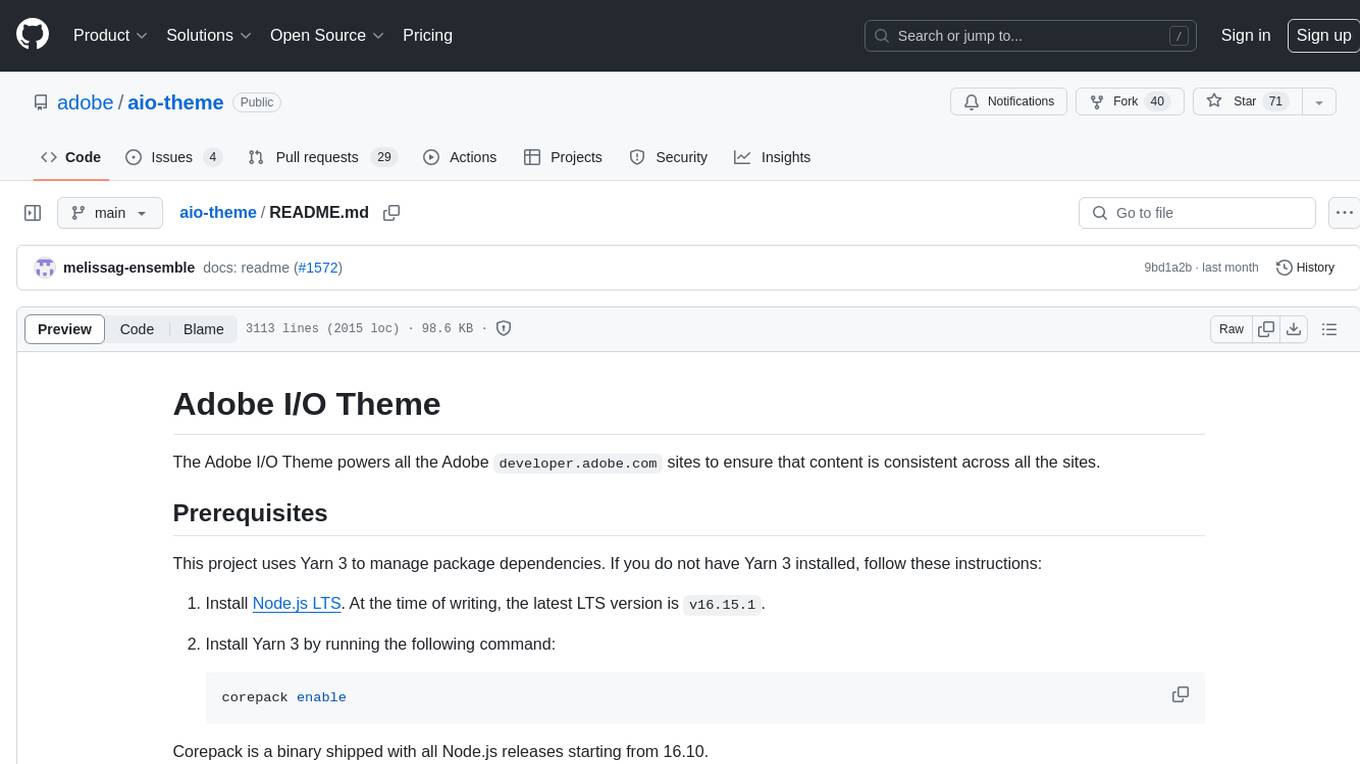
trickPrompt-engine
AI engine for smart contract audit
Stars: 169
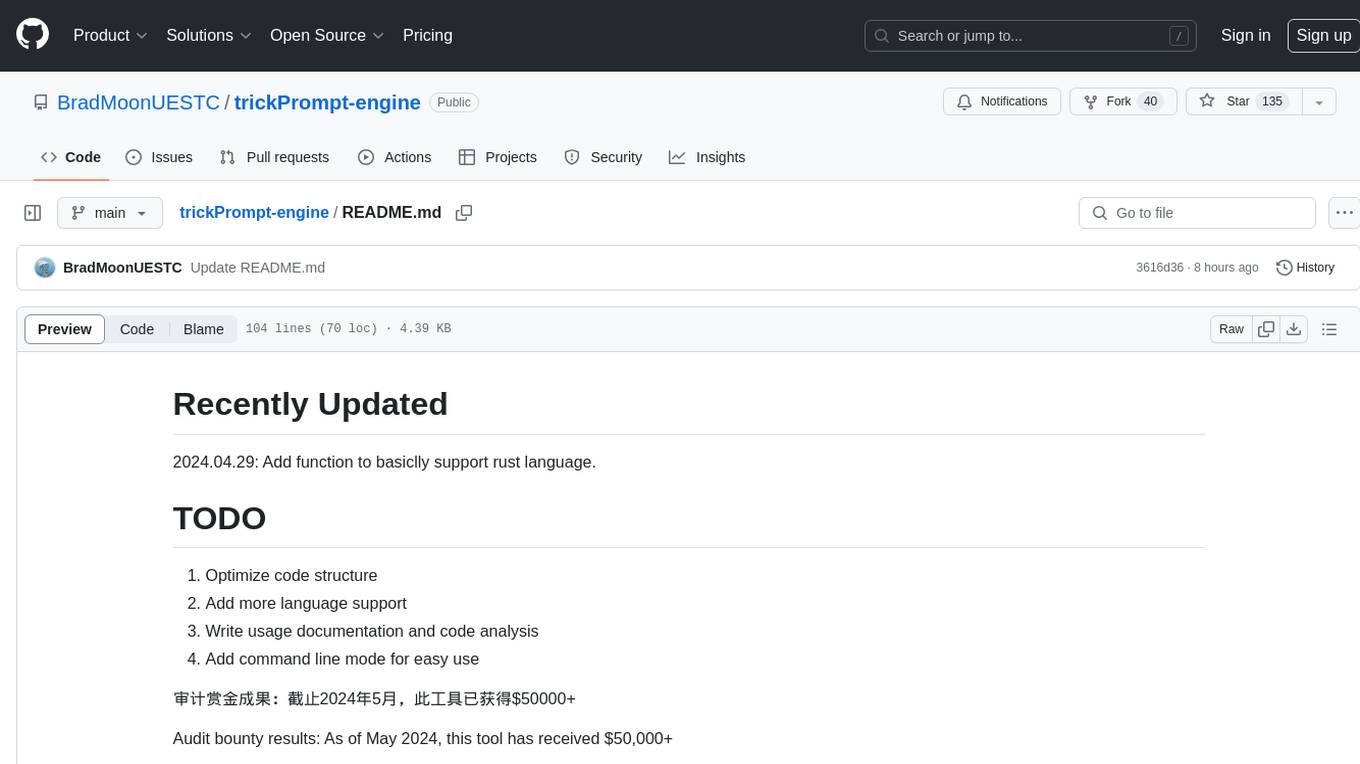
This repository contains a vulnerability mining engine based on GPT technology. The engine is designed to identify logic vulnerabilities in code by utilizing task-driven prompts. It does not require prior knowledge or fine-tuning and focuses on prompt design rather than model design. The tool is effective in real-world projects and should not be used for academic vulnerability testing. It supports scanning projects in various languages, with current support for Solidity. The engine is configured through prompts and environment settings, enabling users to scan for vulnerabilities in their codebase. Future updates aim to optimize code structure, add more language support, and enhance usability through command line mode. The tool has received a significant audit bounty of $50,000+ as of May 2024.
README:
2024.04.29:
- Add function to basiclly support rust language.
2024.05.16:
- Add support for cross-contract vulnerability confirmation, reduce the false positive rate approximately 50%.
- upadte the structure of the db
- add CN explaination
2024.05.18:
- Add prompt for check if result of vulnerability has assumations, reduce the false positive rate approximately 20%.
2024.06.01:
- Add support for python language, dont ask me why, so annoying.
2024.07.01
- Update the license
- Optimize code structure
- Add more language support
- Write usage documentation and code analysis
- Add command line mode for easy use
审计赏金成果:截止2024年5月,此工具已获得$60000+
Audit bounty results: As of May 2024, this tool has received $60,000+
- 优化代码结构
- 增加更多语言支持
- 编写使用文档和代码解析
- 增加命令行模式,方便使用
This is a vulnerability mining engine purely based on GPT, requiring no prior knowledge base, no fine-tuning, yet its effectiveness can overwhelmingly surpass most of the current related research.
The key lies in the design of prompts, which has shown excellent results. The core idea revolves around:
- Being task-driven, not question-driven.
- Driven by prompts, not by code.
- Focused on prompt design, not model design.
The essence is encapsulated in one word: "deception."
- This is a type of code understanding logic vulnerability mining that fully stimulates the capabilities of gpt. The control flow type vulnerability detection ability is ineffective and is suitable for real actual projects.
- Therefore, don’t run tests on meaningless academic vulnerabilities
Here's the translation into English:
Test Environment Setup
-
In the
src/main.pyfile, setswitch_production_or_testtotestto configure the environment in test mode. -
Place the project under the directory
src/dataset/agent-v1-c4. This structure is crucial for proper tool positioning and interaction with data. -
Refer to the configuration file
src/dataset/agent-v1-c4/datasets.jsonto set up your project collection. For example:
"StEverVault2":{
"path":"StEverVault",
"files":[
],
"functions":[]
}Where StEverVault2 represents the custom name of the project, matching the project_id in src/main.py. path refers to the actual path of the project under agent-v1-c4. files specifies the contract files to be scanned; if not configured, it defaults to scanning all files. functions specifies the specific function names to be scanned; if not configured, it defaults to scanning all functions, in the format [contract_name.function_name].
-
Use
src/db.sqlto create the database; PostgreSQL needs to be installed beforehand. -
Set up the
.envfile by creating it and filling in the following details to configure your environment:
# Database connection information
DATABASE_URL=postgresql://postgres:[email protected]:5432/postgres
# OpenAI API
OPENAI_API_BASE="apix.ai-gaochao.cn"
OPENAI_API_KEY=xxxxxx
# Model IDs
BUSINESS_FLOW_MODEL_ID=gpt-4-turbo
VUL_MODEL_ID=gpt-4-turbo
# Business flow scanning parameters
BUSINESS_FLOW_COUNT=10
SWITCH_FUNCTION_CODE=False
SWITCH_BUSINESS_CODE=True
Where:
-
DATABASE_URLis the database connection information. -
OPENAI_API_BASEis the GPT API connection information, usuallyapi.openai.com. -
OPENAI_API_KEYshould be set to your actual OpenAI API key. -
BUSINESS_FLOW_MODEL_IDandVUL_MODEL_IDare the IDs of the models used, recommended to usegpt-4-turbo. -
BUSINESS_FLOW_COUNTis the number of randomizations used to create variability, typically 7-20, commonly 10. -
SWITCH_FUNCTION_CODEandSWITCH_BUSINESS_CODEare the granularity settings during scanning, supporting function-level and business flow-level granularity.
- After configuring, run
main.pyto start the scanning process.
这是一个纯基于gpt的漏洞挖掘引擎,不需要任何前置知识库,不需要任何fine-tuning,但效果足可以碾压当前大部分相关研究的效果
核心关键在于prompt的设计,效果非常好
核心思路:
- task driven, not question driven
- 关键一个字在于“骗”
- 利用幻觉,喜欢幻觉
- 这是一种充分激发gpt能力的代码理解型的逻辑漏洞挖掘,控制流类型的漏洞检测能力效果差,适用于真正的实际项目
- 因此,不要拿那些无意义的学术型漏洞来跑测试
测试环境设置如下:
- 在
src/main.py文件中,将switch_production_or_test设置为test,以配置环境为测试模式。
if __name__ == '__main__':
switch_production_or_test = 'test' # prod / test
if switch_production_or_test == 'test':
# Your code for test environment-
将项目放置于
src/dataset/agent-v1-c4目录下,这一结构对于工具正确定位和与数据交互至关重要。 -
参照
src/dataset/agent-v1-c4/datasets.json配置文件来设置你的项目集。例如:
"StEverVault2":{
"path":"StEverVault",
"files":[
],
"functions":[]
}其中,StEverVault2 代表项目自定义名,它的名字与 src/main.py 中的 project_id 相同。path 指代的是 agent-v1-c4 下项目的具体实际路径。files 指代的是要具体扫描的合约文件,如果不配置,则默认扫描全部。functions 指代的是要具体扫描的函数名,如果不配置,则默认扫描全部函数,形式为【合约名.函数名】。
-
使用
src/db.sql创建数据库,需要提前安装 PostgreSQL。 -
设置
.env文件,通过创建.env文件并填写以下内容来配置你的环境:
# 数据库连接信息
DATABASE_URL=postgresql://postgres:[email protected]:5432/postgres
# OpenAI API
OPENAI_API_BASE="apix.ai-gaochao.cn"
OPENAI_API_KEY=xxxxxx
# 模型ID
BUSINESS_FLOW_MODEL_ID=gpt-4-turbo
VUL_MODEL_ID=gpt-4-turbo
# 业务流扫描参数
BUSINESS_FLOW_COUNT=10
SWITCH_FUNCTION_CODE=False
SWITCH_BUSINESS_CODE=True
其中:
-
DATABASE_URL为数据库连接信息。 -
OPENAI_API_BASE为 GPT API 连接信息,一般情况下为api.openai.com。 -
OPENAI_API_KEY设置为对应的 OpenAI API 密钥。 -
BUSINESS_FLOW_MODEL_ID和VUL_MODEL_ID为所使用的模型 ID,建议使用gpt-4-turbo。 -
BUSINESS_FLOW_COUNT为利用幻觉造成随机性时设置的随机次数,一般为 7-20,常用 10。 -
SWITCH_FUNCTION_CODE和SWITCH_BUSINESS_CODE为扫描时的粒度,支持函数粒度和业务流粒度。
-
配置完成后,运行
main.py即可开始扫描过程。 -
扫描时可能会因为网络原因或api原因中断,对于此已经整理成随时保存,不修改project_id的情况下可以重新运行main.py,可以继续扫描
-
唯一建议gpt4-turbo,不要用3.5,不要用4o,4o和3.5的推理能力是一样的,拉的一批
-
一般扫描时间为2-3小时,取决于项目大小和随机次数,中型项目+10次随机大约2个半小时
-
中型项目+10次随机大约需要20-30美金成本
-
当前还是有误报,按项目大小,大约30-65%,小项目误报会少一些,且还有很多自定义的东西,后续会继续优化
-
结果做了很多标记和中文解释
-
优先看result列中有【"result":"yes"】的(有时候是"result": "yes",带个空格)
-
category列优先筛选出【dont need In-project other contract】 的
-
具体的代码看business_flow_code列
-
代码位置看name列
- gpt4效果会更好,gpt3尚未深入尝试
- 这个tricky prompt理论上经过轻微变种,可以有效的扫描任何语言,但是尽量需要antlr相应语言的ast解析做支持,因为如果有code slicing,效果会更好
- 目前只支持solidity,后续会支持更多语言
刚刚release,还没写完,后续再补充
For Tasks:
Click tags to check more tools for each tasksFor Jobs:
Alternative AI tools for trickPrompt-engine
Similar Open Source Tools

trickPrompt-engine
This repository contains a vulnerability mining engine based on GPT technology. The engine is designed to identify logic vulnerabilities in code by utilizing task-driven prompts. It does not require prior knowledge or fine-tuning and focuses on prompt design rather than model design. The tool is effective in real-world projects and should not be used for academic vulnerability testing. It supports scanning projects in various languages, with current support for Solidity. The engine is configured through prompts and environment settings, enabling users to scan for vulnerabilities in their codebase. Future updates aim to optimize code structure, add more language support, and enhance usability through command line mode. The tool has received a significant audit bounty of $50,000+ as of May 2024.
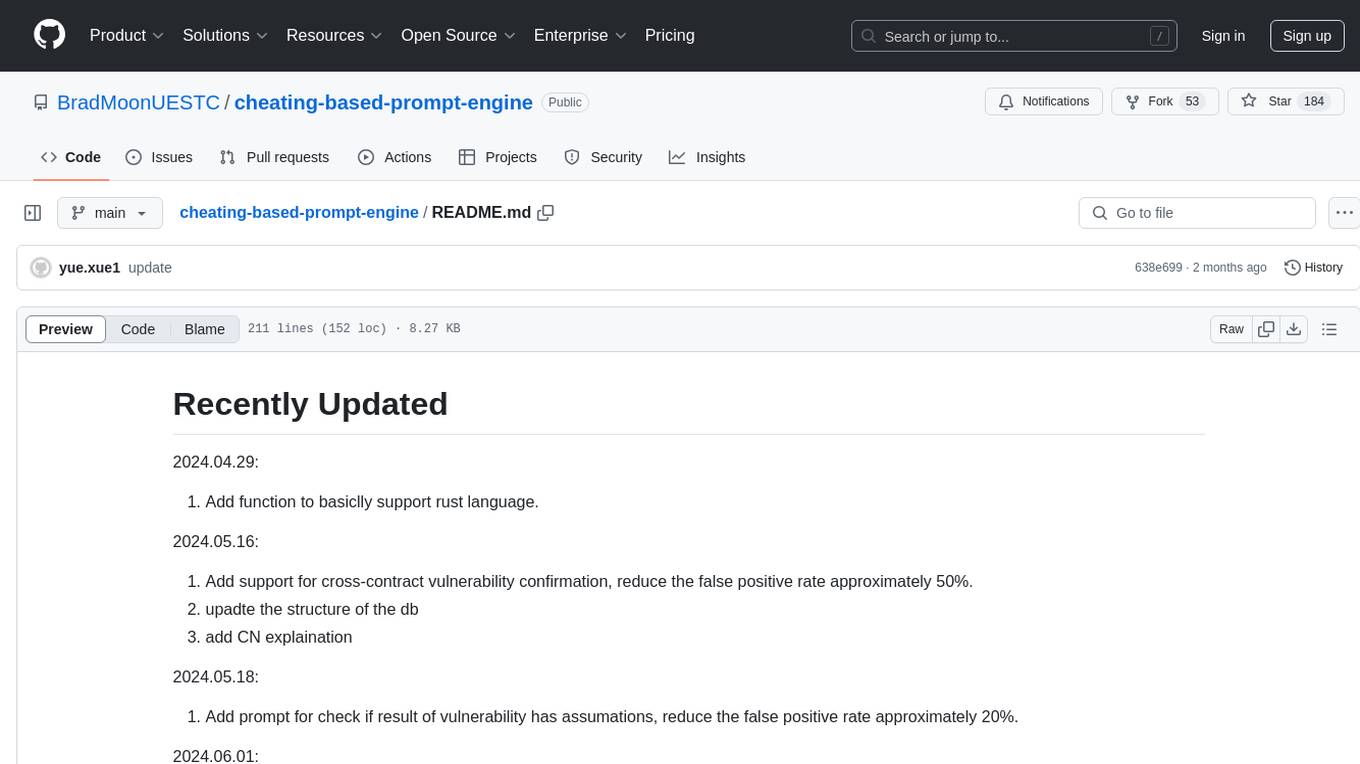
cheating-based-prompt-engine
This is a vulnerability mining engine purely based on GPT, requiring no prior knowledge base, no fine-tuning, yet its effectiveness can overwhelmingly surpass most of the current related research. The core idea revolves around being task-driven, not question-driven, driven by prompts, not by code, and focused on prompt design, not model design. The essence is encapsulated in one word: deception. It is a type of code understanding logic vulnerability mining that fully stimulates the capabilities of GPT, suitable for real actual projects.
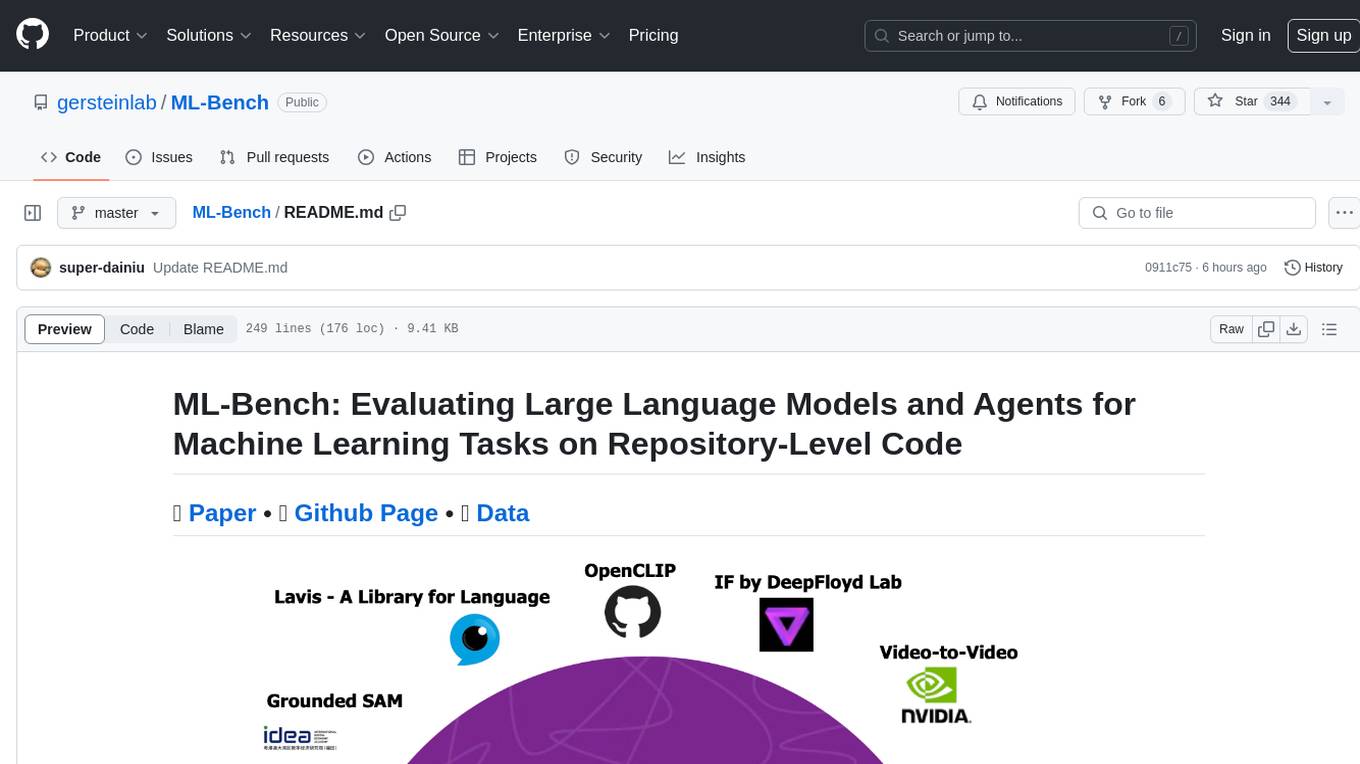
ML-Bench
ML-Bench is a tool designed to evaluate large language models and agents for machine learning tasks on repository-level code. It provides functionalities for data preparation, environment setup, usage, API calling, open source model fine-tuning, and inference. Users can clone the repository, load datasets, run ML-LLM-Bench, prepare data, fine-tune models, and perform inference tasks. The tool aims to facilitate the evaluation of language models and agents in the context of machine learning tasks on code repositories.
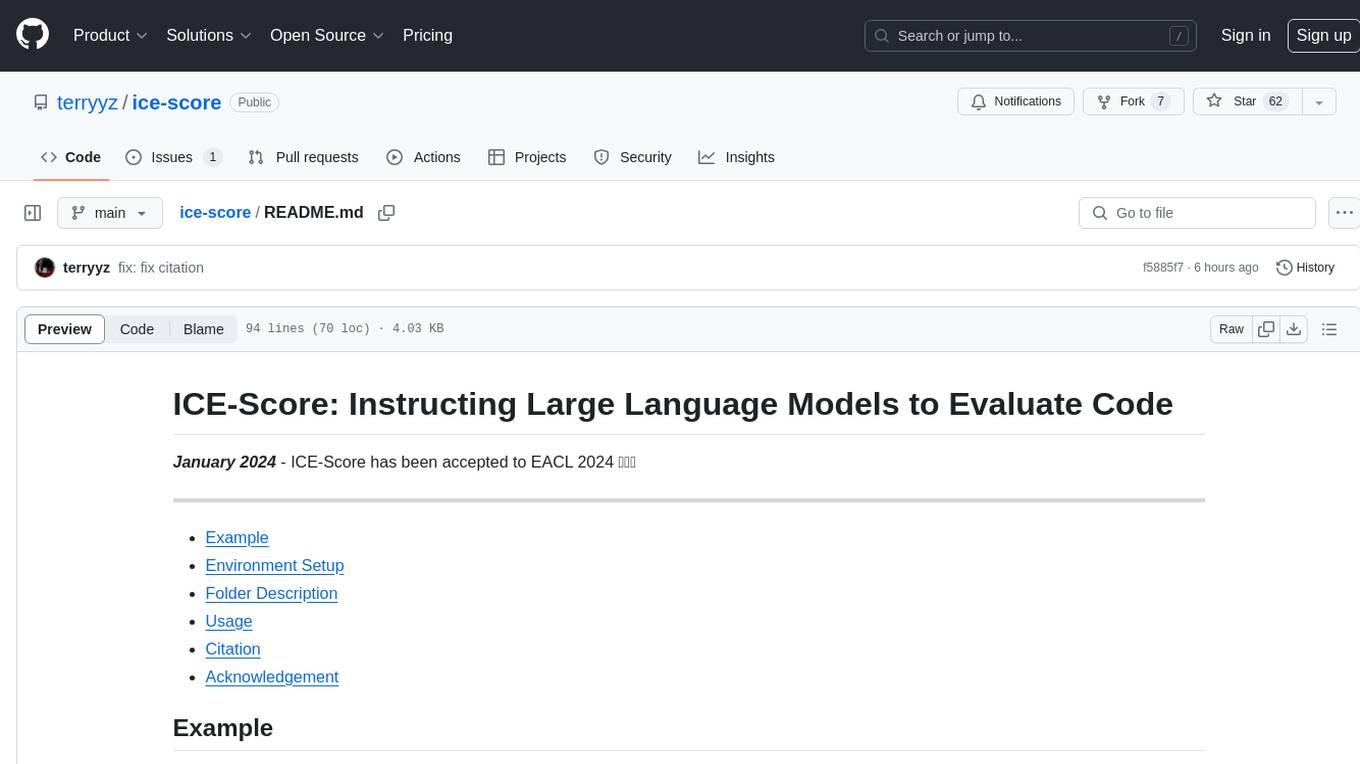
ice-score
ICE-Score is a tool designed to instruct large language models to evaluate code. It provides a minimum viable product (MVP) for evaluating generated code snippets using inputs such as problem, output, task, aspect, and model. Users can also evaluate with reference code and enable zero-shot chain-of-thought evaluation. The tool is built on codegen-metrics and code-bert-score repositories and includes datasets like CoNaLa and HumanEval. ICE-Score has been accepted to EACL 2024.
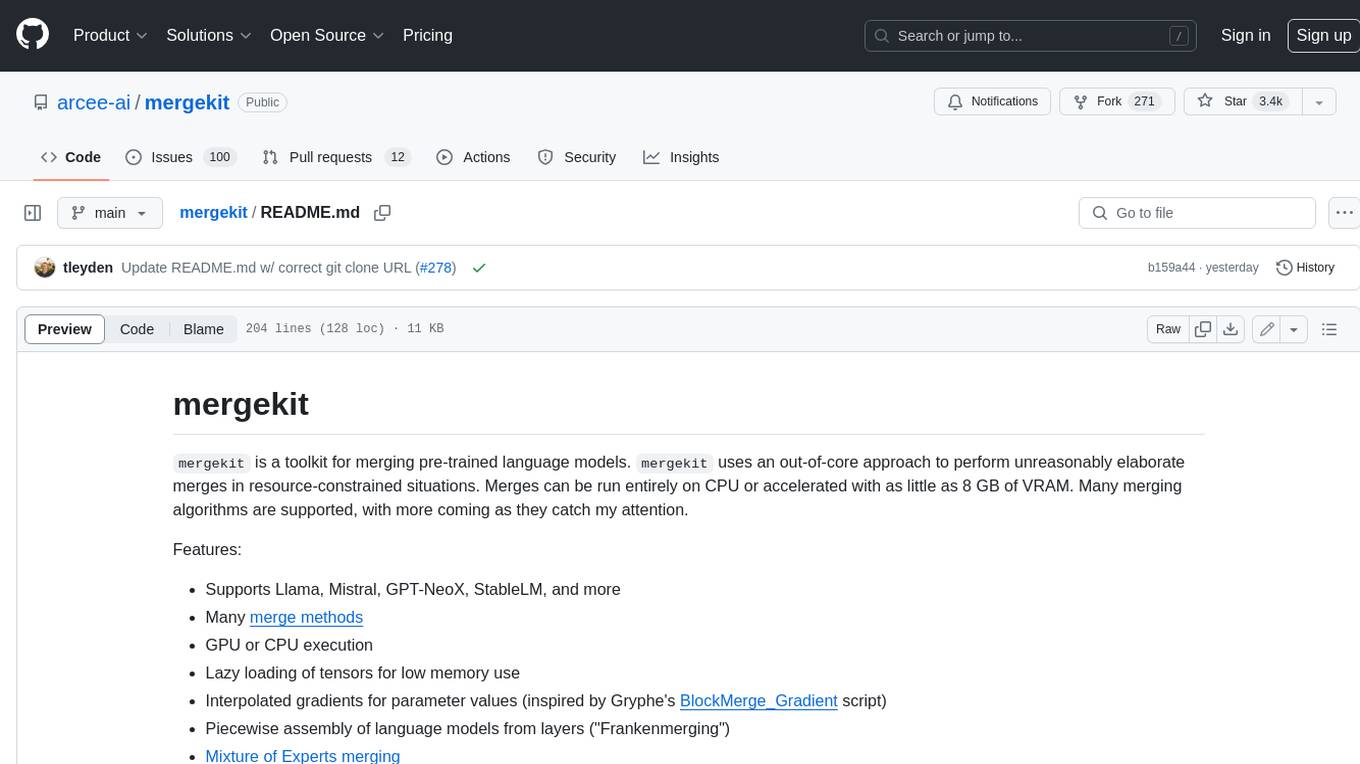
mergekit
Mergekit is a toolkit for merging pre-trained language models. It uses an out-of-core approach to perform unreasonably elaborate merges in resource-constrained situations. Merges can be run entirely on CPU or accelerated with as little as 8 GB of VRAM. Many merging algorithms are supported, with more coming as they catch my attention.
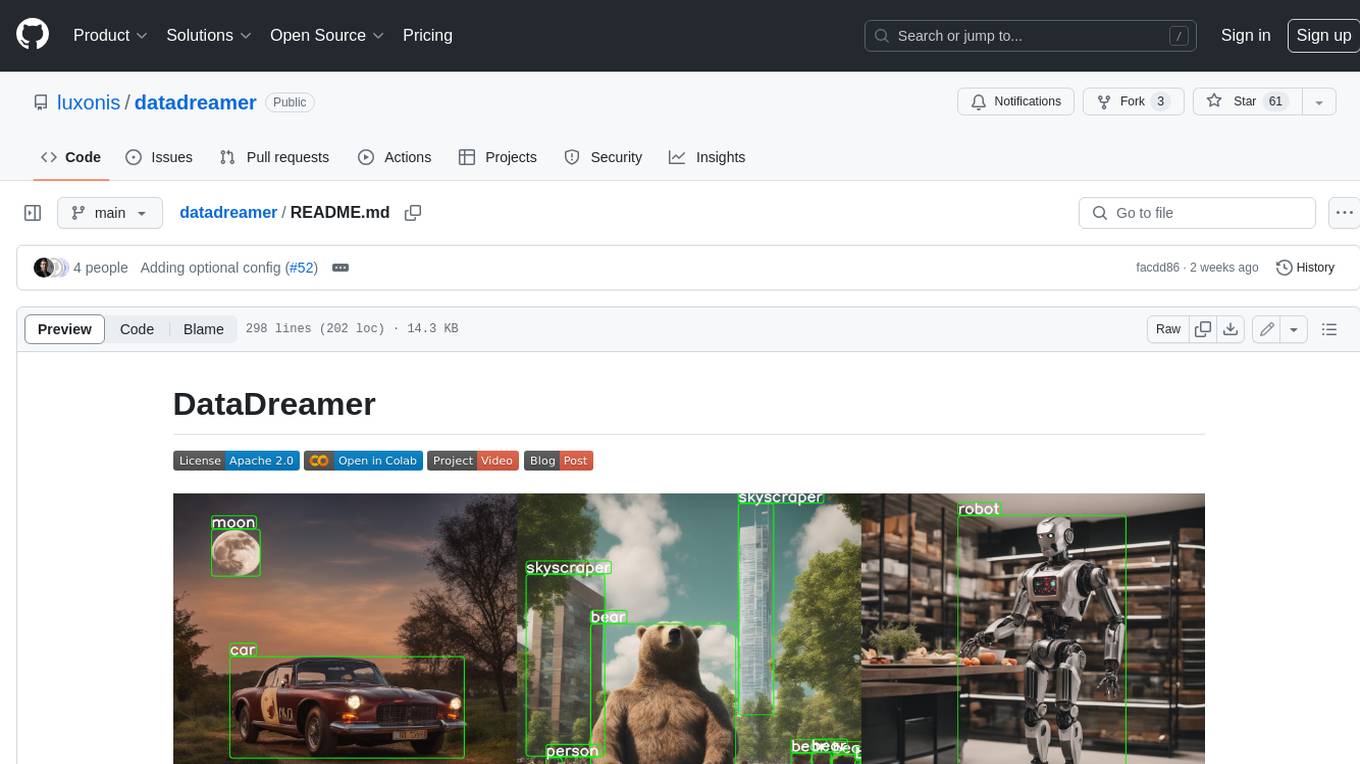
datadreamer
DataDreamer is an advanced toolkit designed to facilitate the development of edge AI models by enabling synthetic data generation, knowledge extraction from pre-trained models, and creation of efficient and potent models. It eliminates the need for extensive datasets by generating synthetic datasets, leverages latent knowledge from pre-trained models, and focuses on creating compact models suitable for integration into any device and performance for specialized tasks. The toolkit offers features like prompt generation, image generation, dataset annotation, and tools for training small-scale neural networks for edge deployment. It provides hardware requirements, usage instructions, available models, and limitations to consider while using the library.
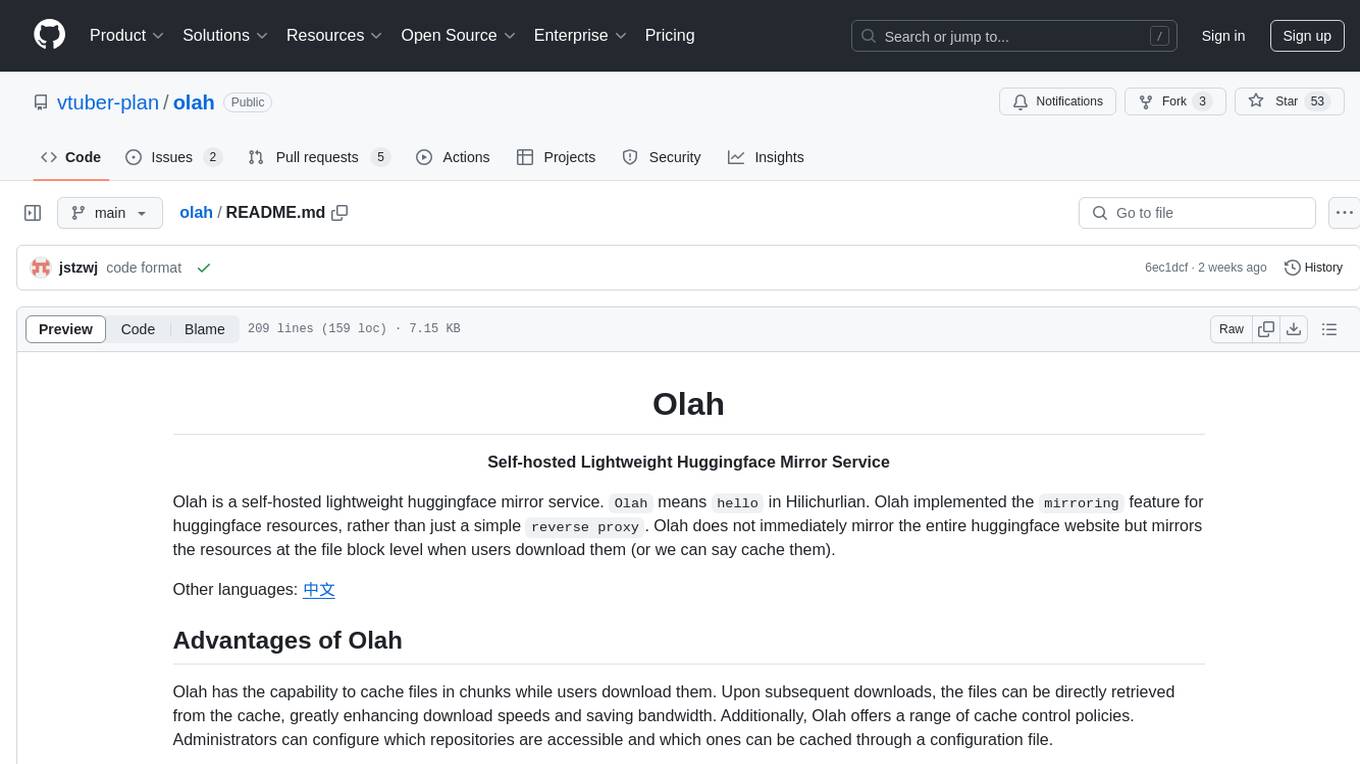
olah
Olah is a self-hosted lightweight Huggingface mirror service that implements mirroring feature for Huggingface resources at file block level, enhancing download speeds and saving bandwidth. It offers cache control policies and allows administrators to configure accessible repositories. Users can install Olah with pip or from source, set up the mirror site, and download models and datasets using huggingface-cli. Olah provides additional configurations through a configuration file for basic setup and accessibility restrictions. Future work includes implementing an administrator and user system, OOS backend support, and mirror update schedule task. Olah is released under the MIT License.
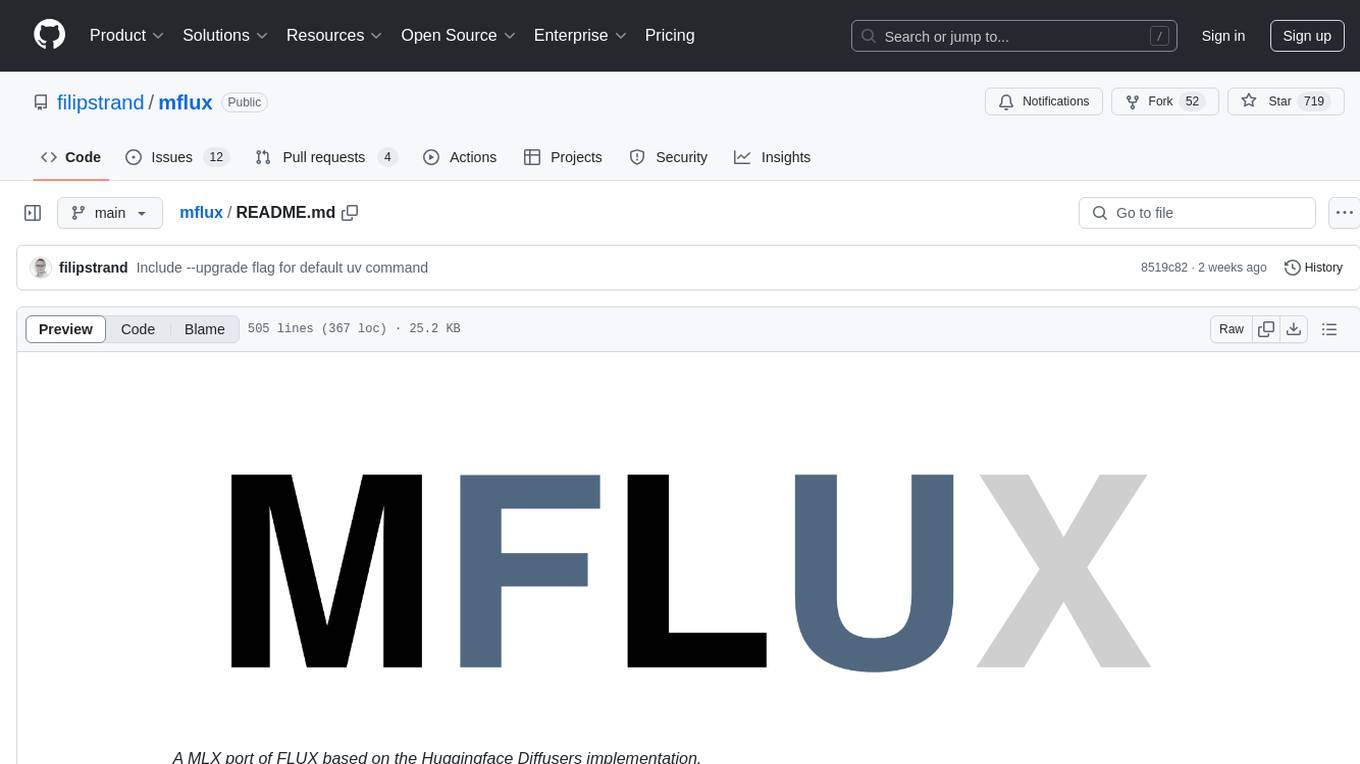
mflux
MFLUX is a line-by-line port of the FLUX implementation in the Huggingface Diffusers library to Apple MLX. It aims to run powerful FLUX models from Black Forest Labs locally on Mac machines. The codebase is minimal and explicit, prioritizing readability over generality and performance. Models are implemented from scratch in MLX, with tokenizers from the Huggingface Transformers library. Dependencies include Numpy and Pillow for image post-processing. Installation can be done using `uv tool` or classic virtual environment setup. Command-line arguments allow for image generation with specified models, prompts, and optional parameters. Quantization options for speed and memory reduction are available. LoRA adapters can be loaded for fine-tuning image generation. Controlnet support provides more control over image generation with reference images. Current limitations include generating images one by one, lack of support for negative prompts, and some LoRA adapters not working.
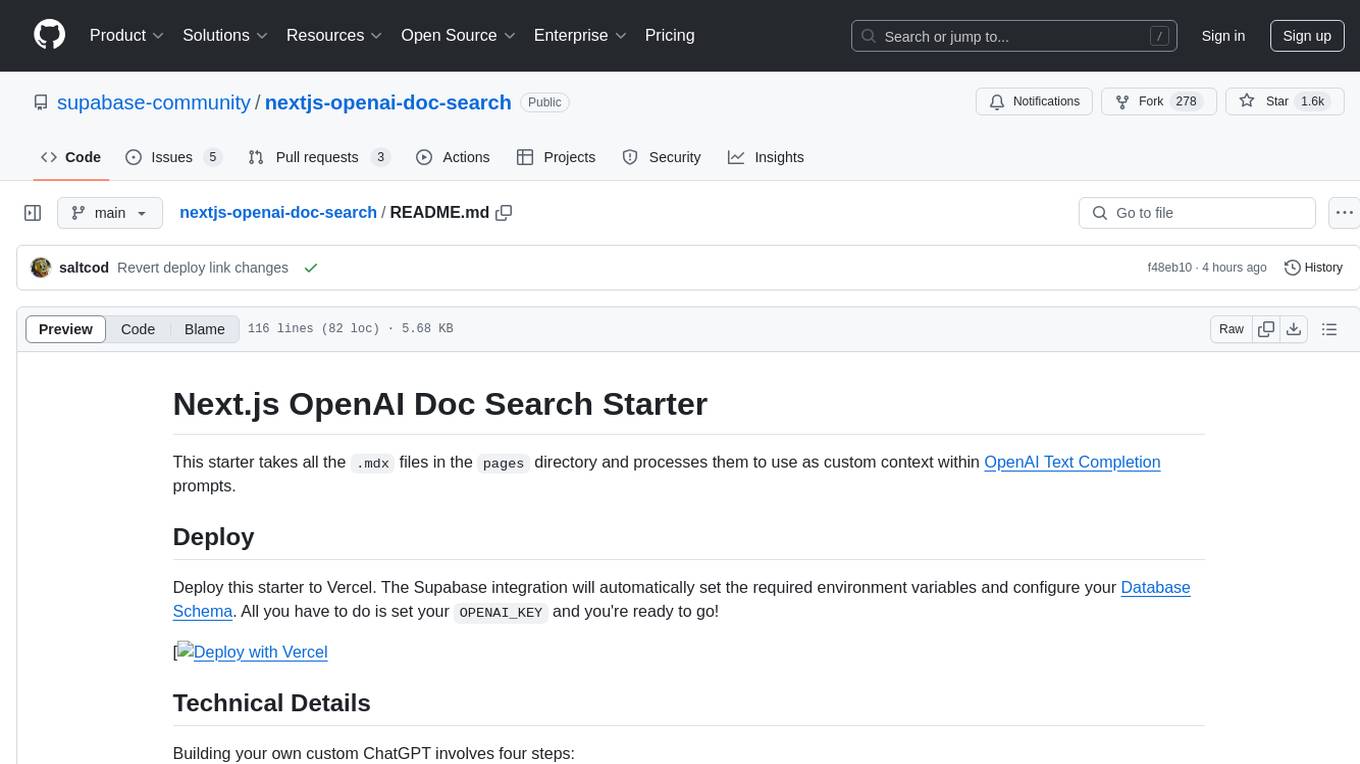
nextjs-openai-doc-search
This starter project is designed to process `.mdx` files in the `pages` directory to use as custom context within OpenAI Text Completion prompts. It involves building a custom ChatGPT style doc search powered by Next.js, OpenAI, and Supabase. The project includes steps for pre-processing knowledge base, storing embeddings in Postgres, performing vector similarity search, and injecting content into OpenAI GPT-3 text completion prompt.
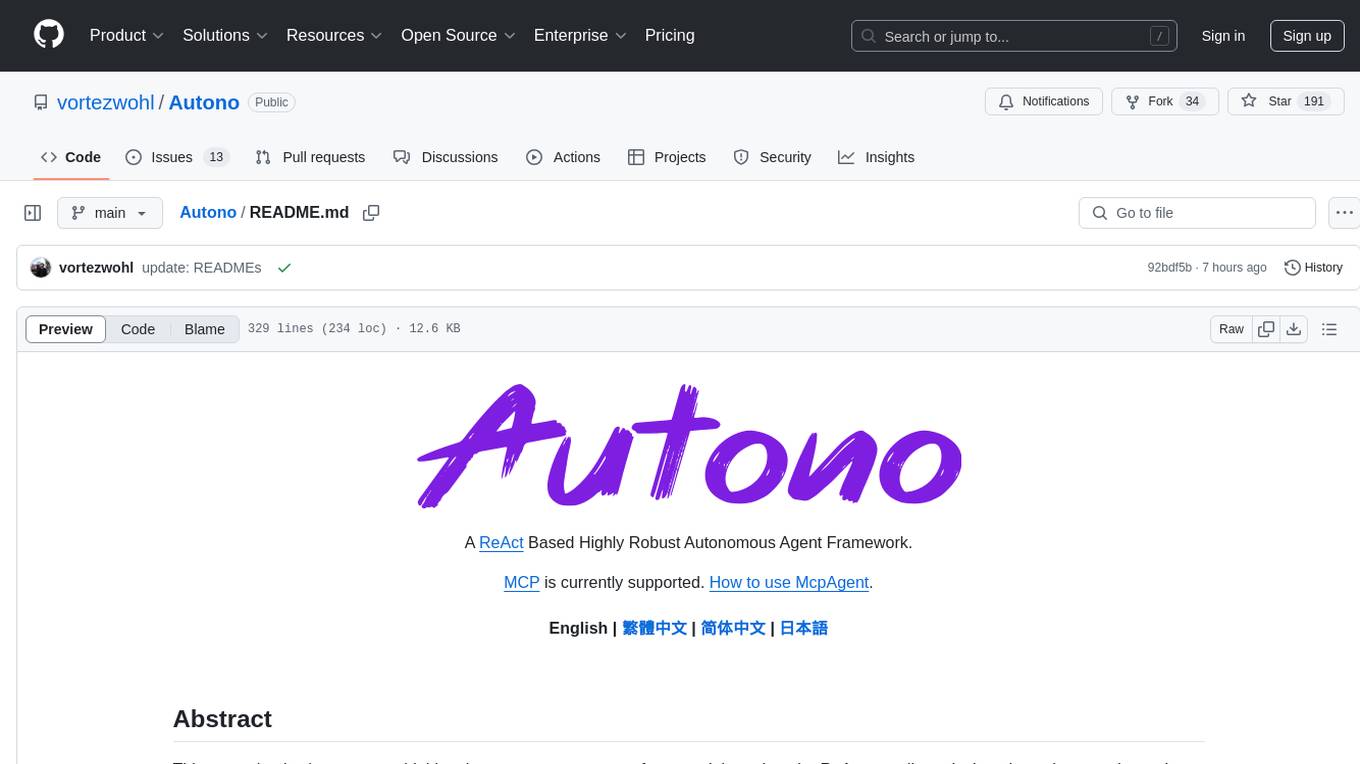
Autono
A highly robust autonomous agent framework based on the ReAct paradigm, designed for adaptive decision making and multi-agent collaboration. It dynamically generates next actions during agent execution, enhancing robustness. Features a timely abandonment strategy and memory transfer mechanism for multi-agent collaboration. The framework allows developers to balance conservative and exploratory tendencies in agent execution strategies, improving adaptability and task execution efficiency in complex environments. Supports external tool integration, modular design, and MCP protocol compatibility for flexible action space expansion. Multi-agent collaboration mechanism enables agents to focus on specific task components, improving execution efficiency and quality.
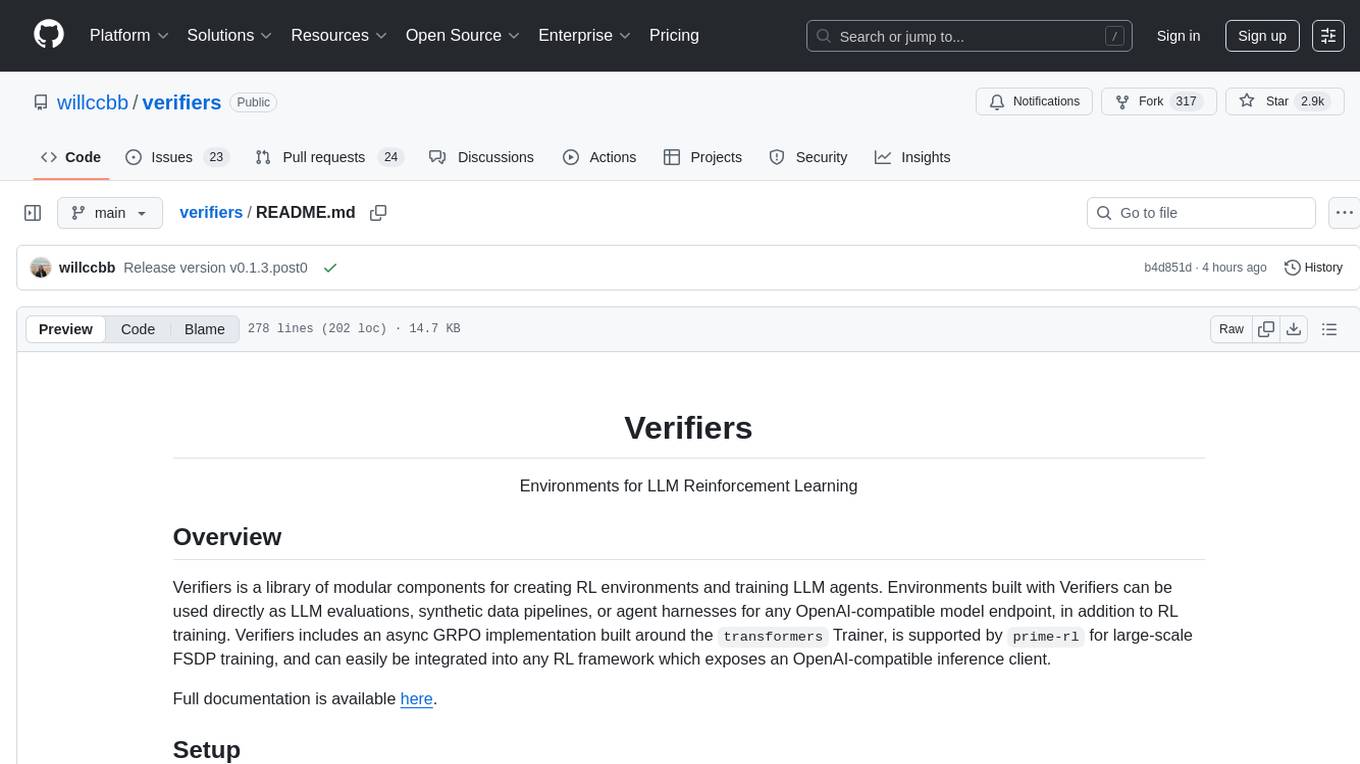
verifiers
Verifiers is a library of modular components for creating RL environments and training LLM agents. It includes an async GRPO implementation built around the `transformers` Trainer, is supported by `prime-rl` for large-scale FSDP training, and can easily be integrated into any RL framework which exposes an OpenAI-compatible inference client. The library provides tools for creating and evaluating RL environments, training LLM agents, and leveraging OpenAI-compatible models for various tasks. Verifiers aims to be a reliable toolkit for building on top of, minimizing fork proliferation in the RL infrastructure ecosystem.
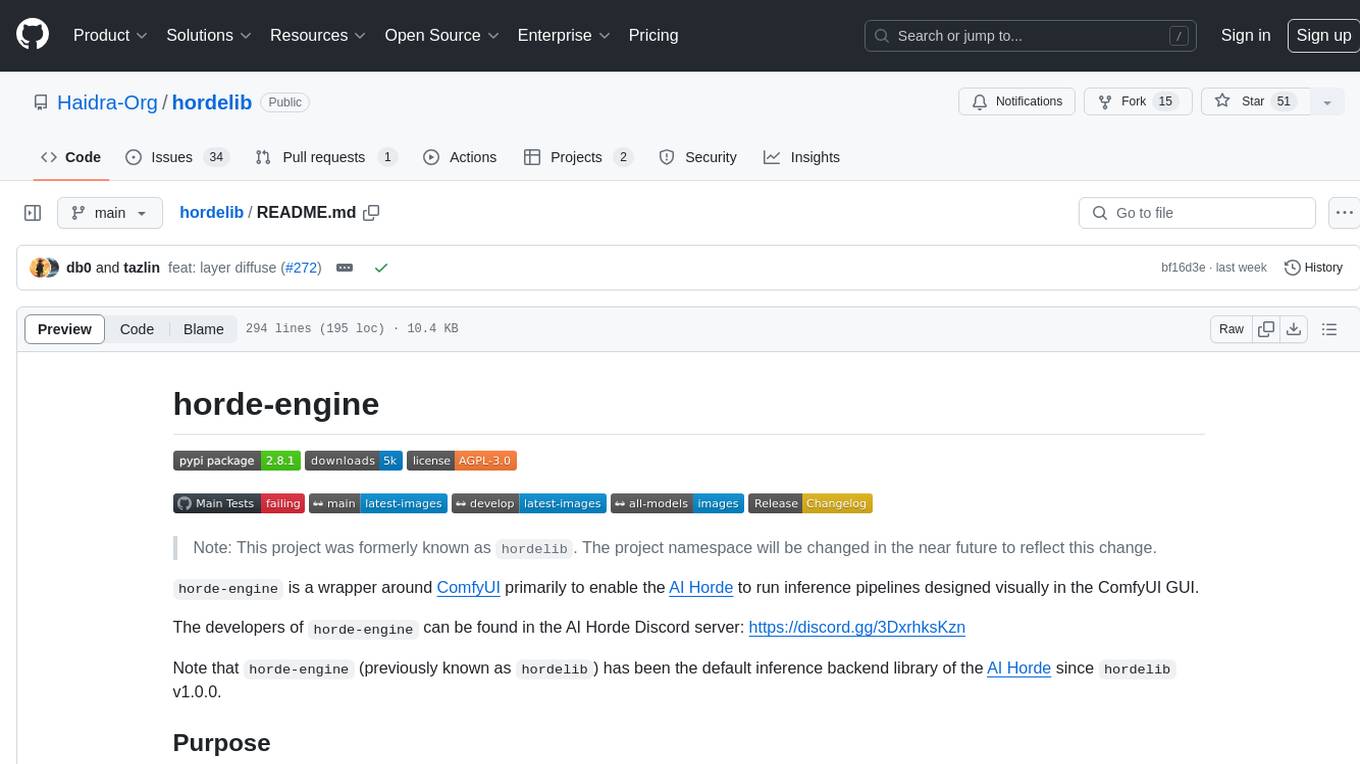
hordelib
horde-engine is a wrapper around ComfyUI designed to run inference pipelines visually designed in the ComfyUI GUI. It enables users to design inference pipelines in ComfyUI and then call them programmatically, maintaining compatibility with the existing horde implementation. The library provides features for processing Horde payloads, initializing the library, downloading and validating models, and generating images based on input data. It also includes custom nodes for preprocessing and tasks such as face restoration and QR code generation. The project depends on various open source projects and bundles some dependencies within the library itself. Users can design ComfyUI pipelines, convert them to the backend format, and run them using the run_image_pipeline() method in hordelib.comfy.Comfy(). The project is actively developed and tested using git, tox, and a specific model directory structure.
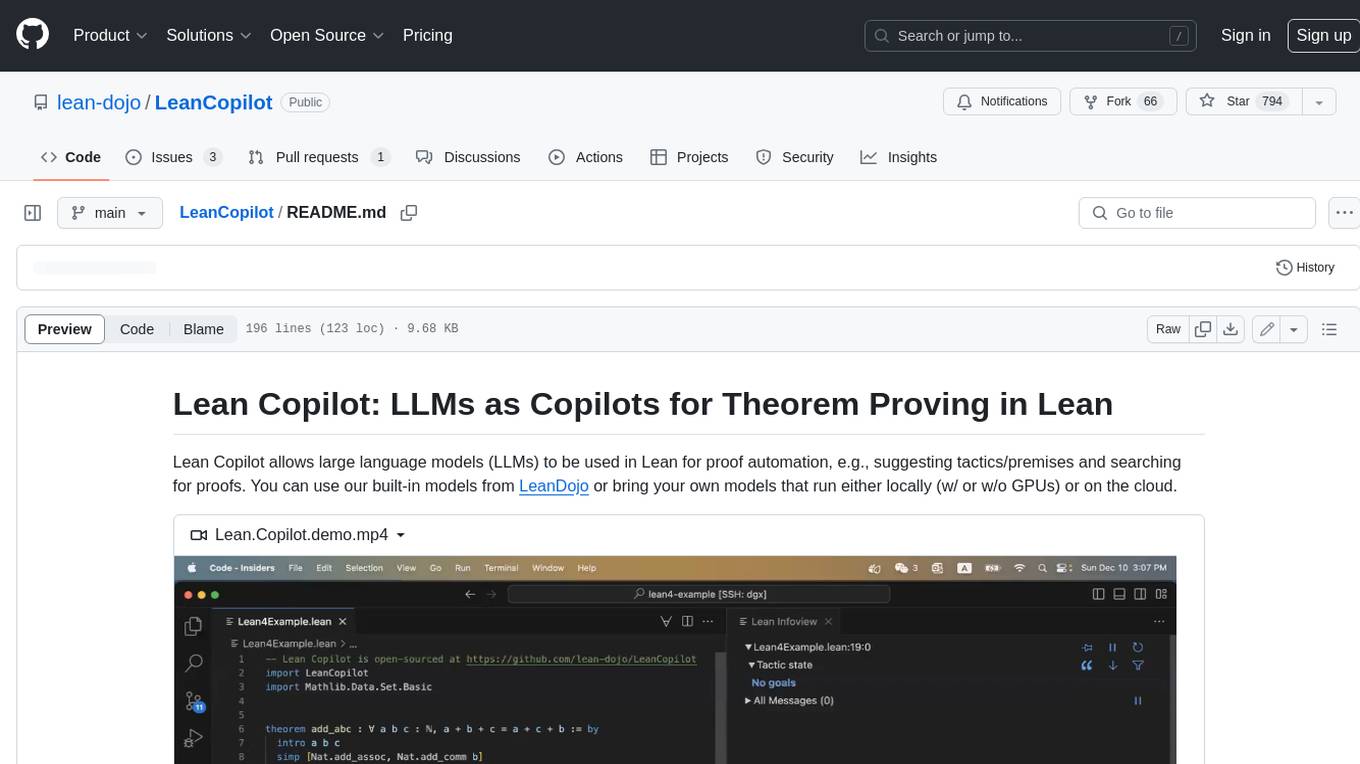
LeanCopilot
Lean Copilot is a tool that enables the use of large language models (LLMs) in Lean for proof automation. It provides features such as suggesting tactics/premises, searching for proofs, and running inference of LLMs. Users can utilize built-in models from LeanDojo or bring their own models to run locally or on the cloud. The tool supports platforms like Linux, macOS, and Windows WSL, with optional CUDA and cuDNN for GPU acceleration. Advanced users can customize behavior using Tactic APIs and Model APIs. Lean Copilot also allows users to bring their own models through ExternalGenerator or ExternalEncoder. The tool comes with caveats such as occasional crashes and issues with premise selection and proof search. Users can get in touch through GitHub Discussions for questions, bug reports, feature requests, and suggestions. The tool is designed to enhance theorem proving in Lean using LLMs.
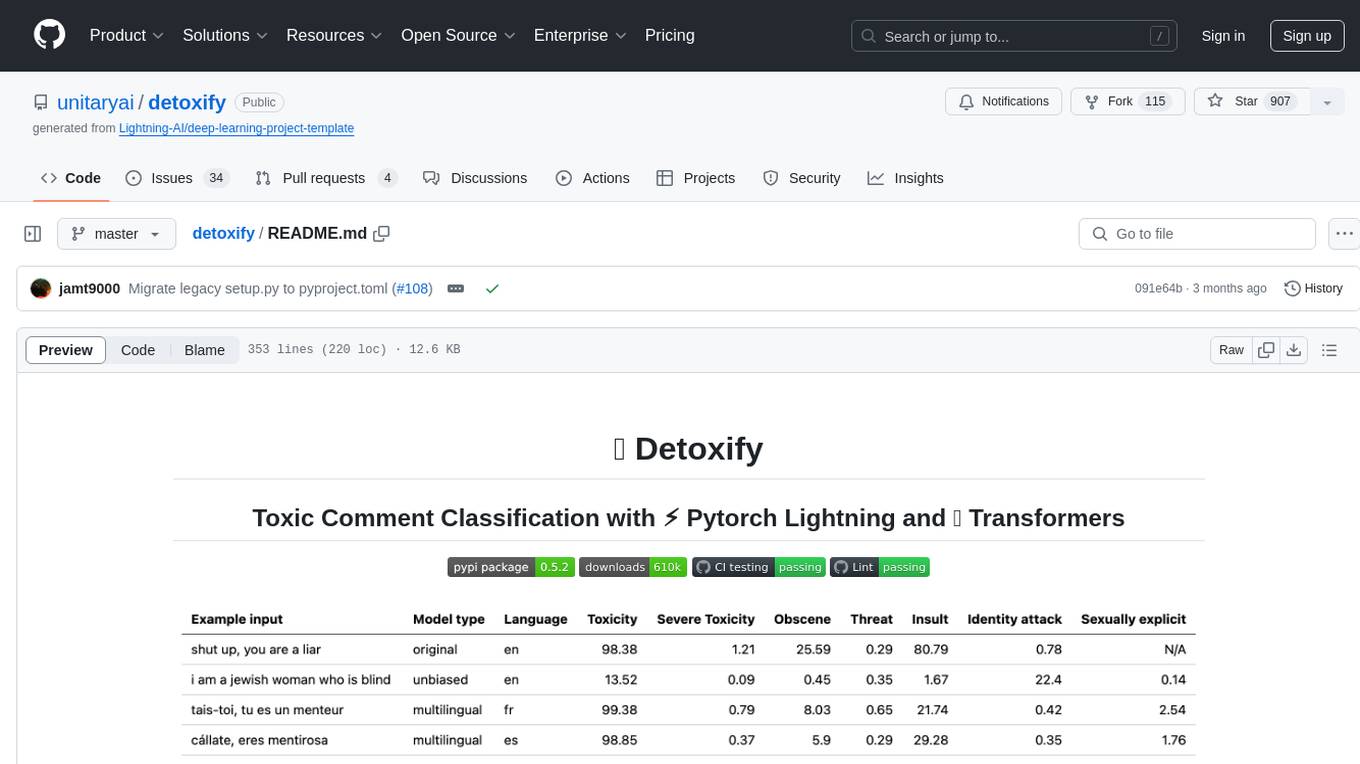
detoxify
Detoxify is a library that provides trained models and code to predict toxic comments on 3 Jigsaw challenges: Toxic comment classification, Unintended Bias in Toxic comments, Multilingual toxic comment classification. It includes models like 'original', 'unbiased', and 'multilingual' trained on different datasets to detect toxicity and minimize bias. The library aims to help in stopping harmful content online by interpreting visual content in context. Users can fine-tune the models on carefully constructed datasets for research purposes or to aid content moderators in flagging out harmful content quicker. The library is built to be user-friendly and straightforward to use.
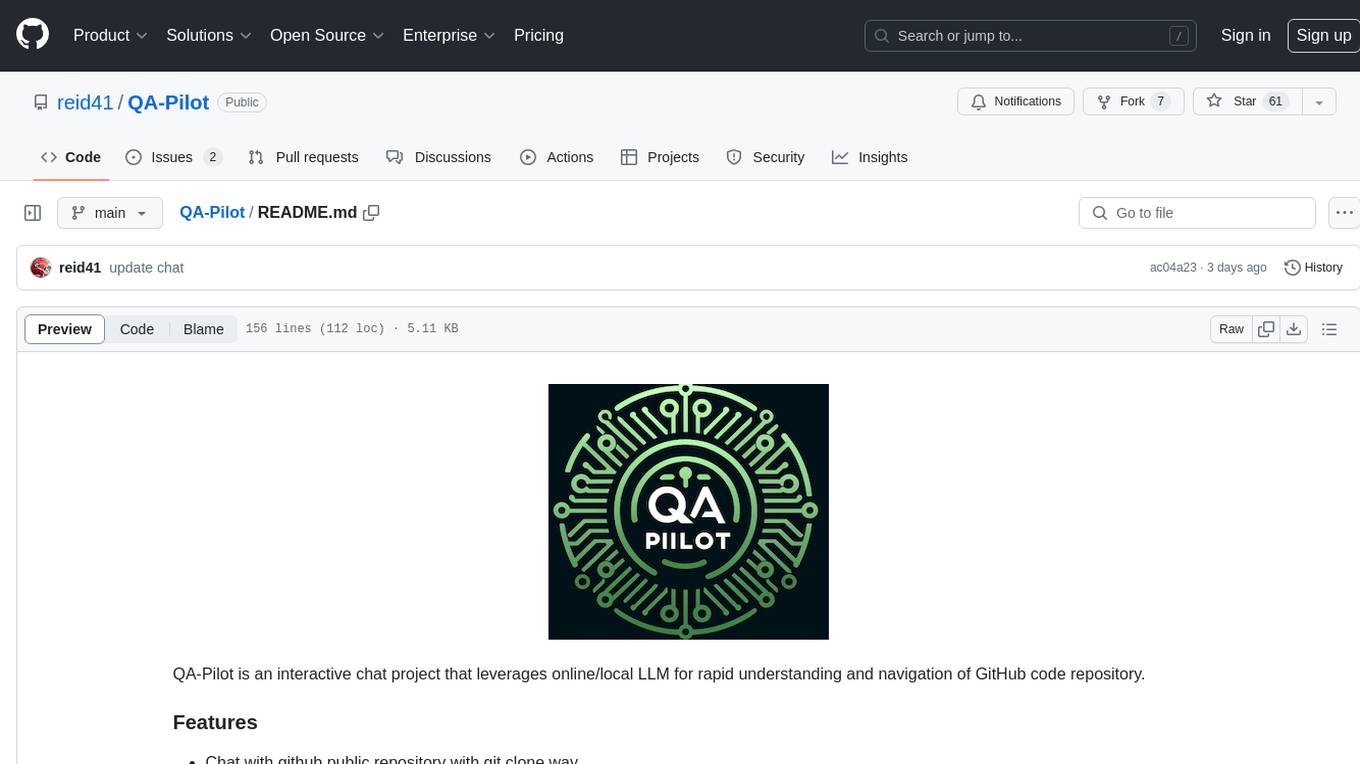
QA-Pilot
QA-Pilot is an interactive chat project that leverages online/local LLM for rapid understanding and navigation of GitHub code repository. It allows users to chat with GitHub public repositories using a git clone approach, store chat history, configure settings easily, manage multiple chat sessions, and quickly locate sessions with a search function. The tool integrates with `codegraph` to view Python files and supports various LLM models such as ollama, openai, mistralai, and localai. The project is continuously updated with new features and improvements, such as converting from `flask` to `fastapi`, adding `localai` API support, and upgrading dependencies like `langchain` and `Streamlit` to enhance performance.
For similar tasks

trickPrompt-engine
This repository contains a vulnerability mining engine based on GPT technology. The engine is designed to identify logic vulnerabilities in code by utilizing task-driven prompts. It does not require prior knowledge or fine-tuning and focuses on prompt design rather than model design. The tool is effective in real-world projects and should not be used for academic vulnerability testing. It supports scanning projects in various languages, with current support for Solidity. The engine is configured through prompts and environment settings, enabling users to scan for vulnerabilities in their codebase. Future updates aim to optimize code structure, add more language support, and enhance usability through command line mode. The tool has received a significant audit bounty of $50,000+ as of May 2024.
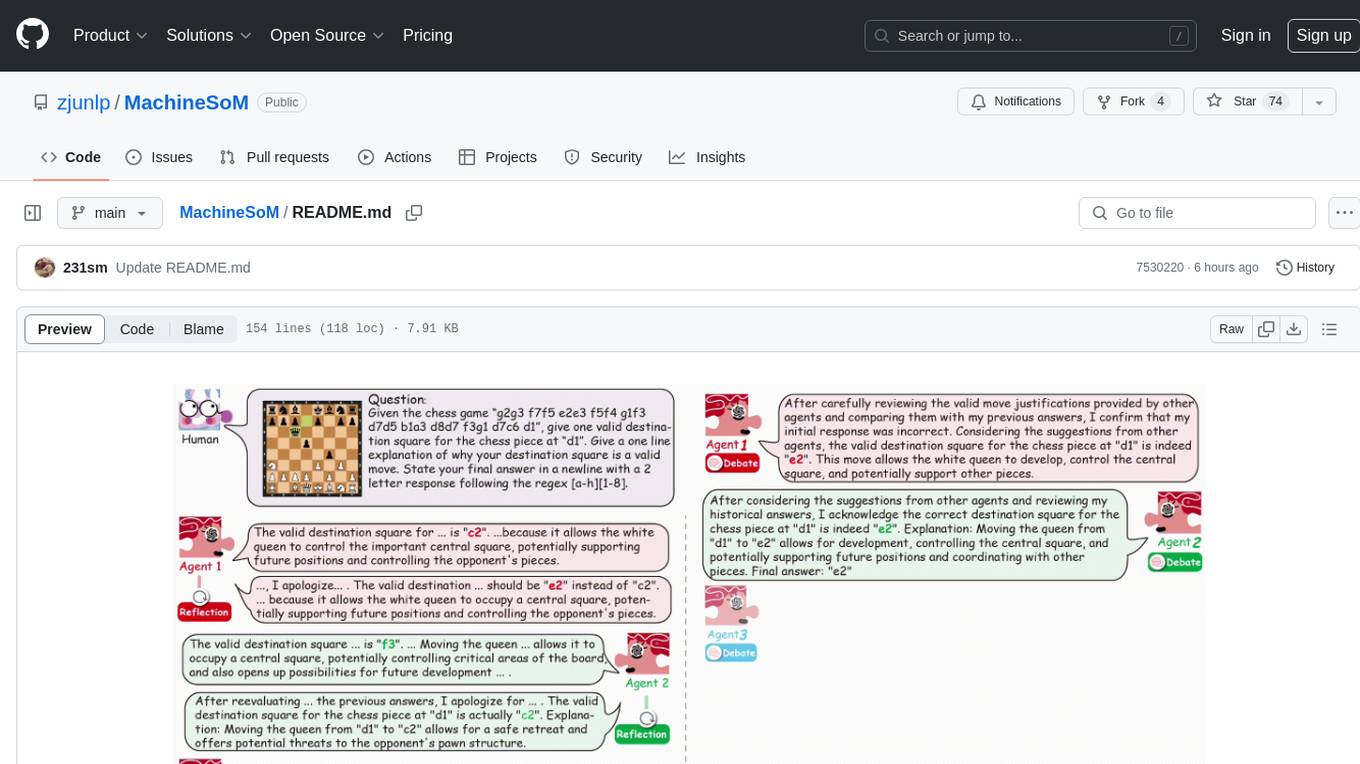
MachineSoM
MachineSoM is a code repository for the paper 'Exploring Collaboration Mechanisms for LLM Agents: A Social Psychology View'. It focuses on the emergence of intelligence from collaborative and communicative computational modules, enabling effective completion of complex tasks. The repository includes code for societies of LLM agents with different traits, collaboration processes such as debate and self-reflection, and interaction strategies for determining when and with whom to interact. It provides a coding framework compatible with various inference services like Replicate, OpenAI, Dashscope, and Anyscale, supporting models like Qwen and GPT. Users can run experiments, evaluate results, and draw figures based on the paper's content, with available datasets for MMLU, Math, and Chess Move Validity.
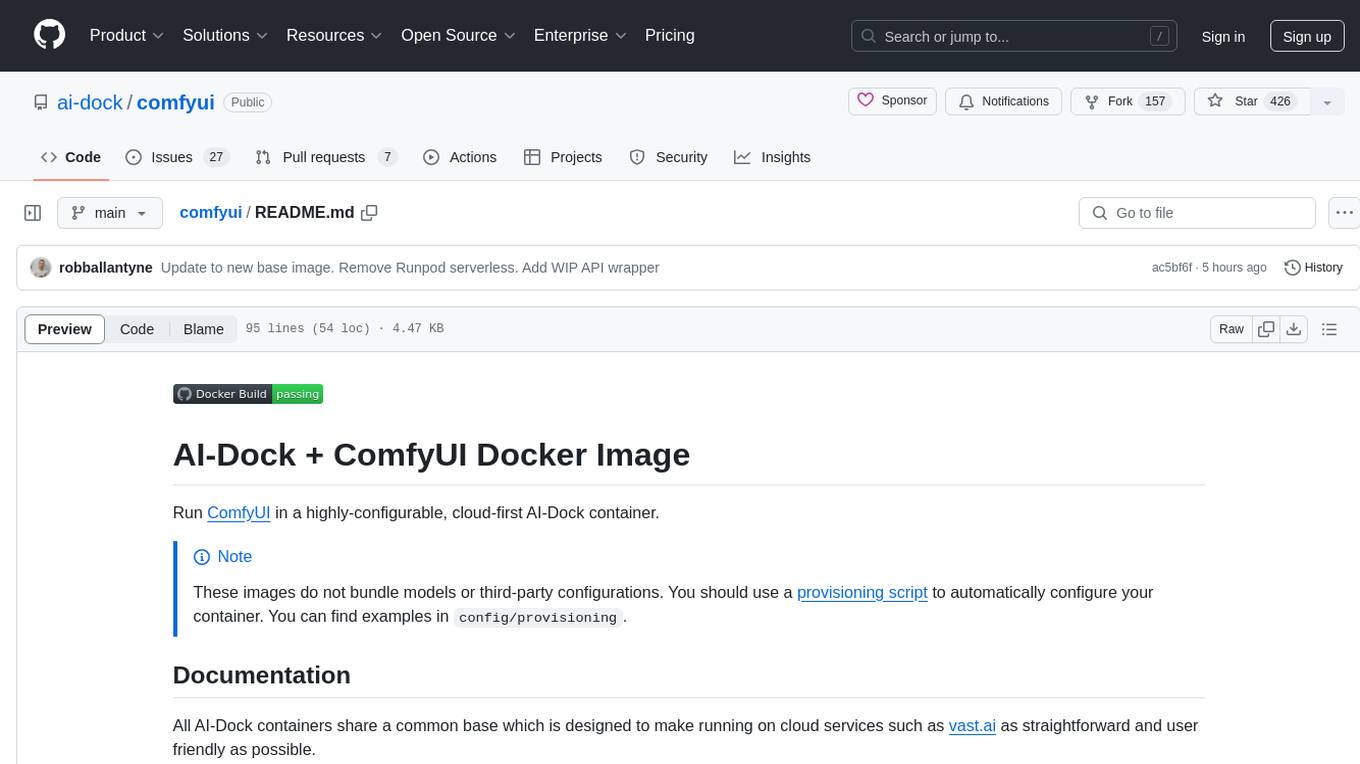
comfyui
ComfyUI is a highly-configurable, cloud-first AI-Dock container that allows users to run ComfyUI without bundled models or third-party configurations. Users can configure the container using provisioning scripts. The Docker image supports NVIDIA CUDA, AMD ROCm, and CPU platforms, with version tags for different configurations. Additional environment variables and Python environments are provided for customization. ComfyUI service runs on port 8188 and can be managed using supervisorctl. The tool also includes an API wrapper service and pre-configured templates for Vast.ai. The author may receive compensation for services linked in the documentation.

pyrfuniverse
pyrfuniverse is a python package used to interact with RFUniverse simulation environment. It is developed with reference to ML-Agents and produce new features. The package allows users to work with RFUniverse for simulation purposes, providing tools and functionalities to interact with the environment and create new features.
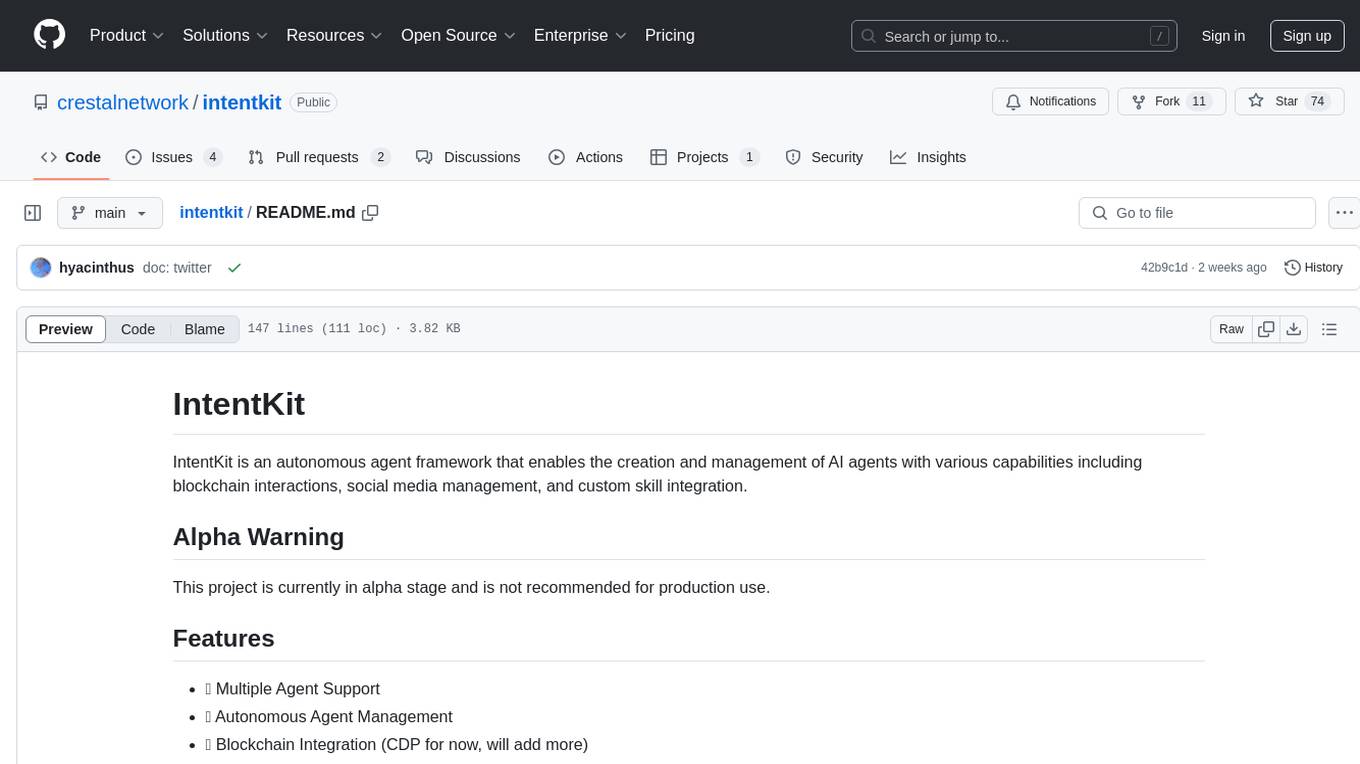
intentkit
IntentKit is an autonomous agent framework that enables the creation and management of AI agents with capabilities including blockchain interactions, social media management, and custom skill integration. It supports multiple agents, autonomous agent management, blockchain integration, social media integration, extensible skill system, and plugin system. The project is in alpha stage and not recommended for production use. It provides quick start guides for Docker and local development, integrations with Twitter and Coinbase, configuration options using environment variables or AWS Secrets Manager, project structure with core application code, entry points, configuration management, database models, skills, skill sets, and utility functions. Developers can add new skills by creating, implementing, and registering them in the skill directory.
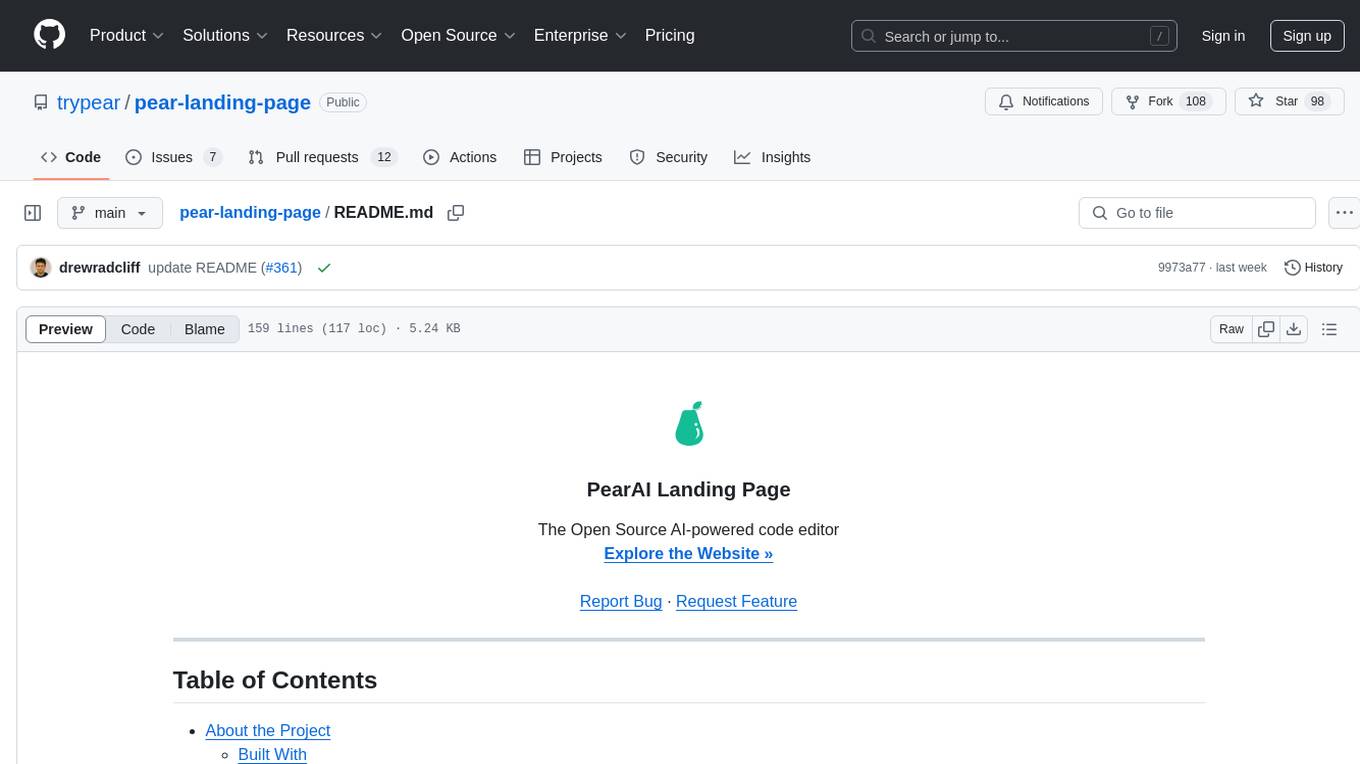
pear-landing-page
PearAI Landing Page is an open-source AI-powered code editor managed by Nang and Pan. It is built with Next.js, Vercel, Tailwind CSS, and TypeScript. The project requires setting up environment variables for proper configuration. Users can run the project locally by starting the development server and visiting the specified URL in the browser. Recommended extensions include Prettier, ESLint, and JavaScript and TypeScript Nightly. Contributions to the project are welcomed and appreciated.
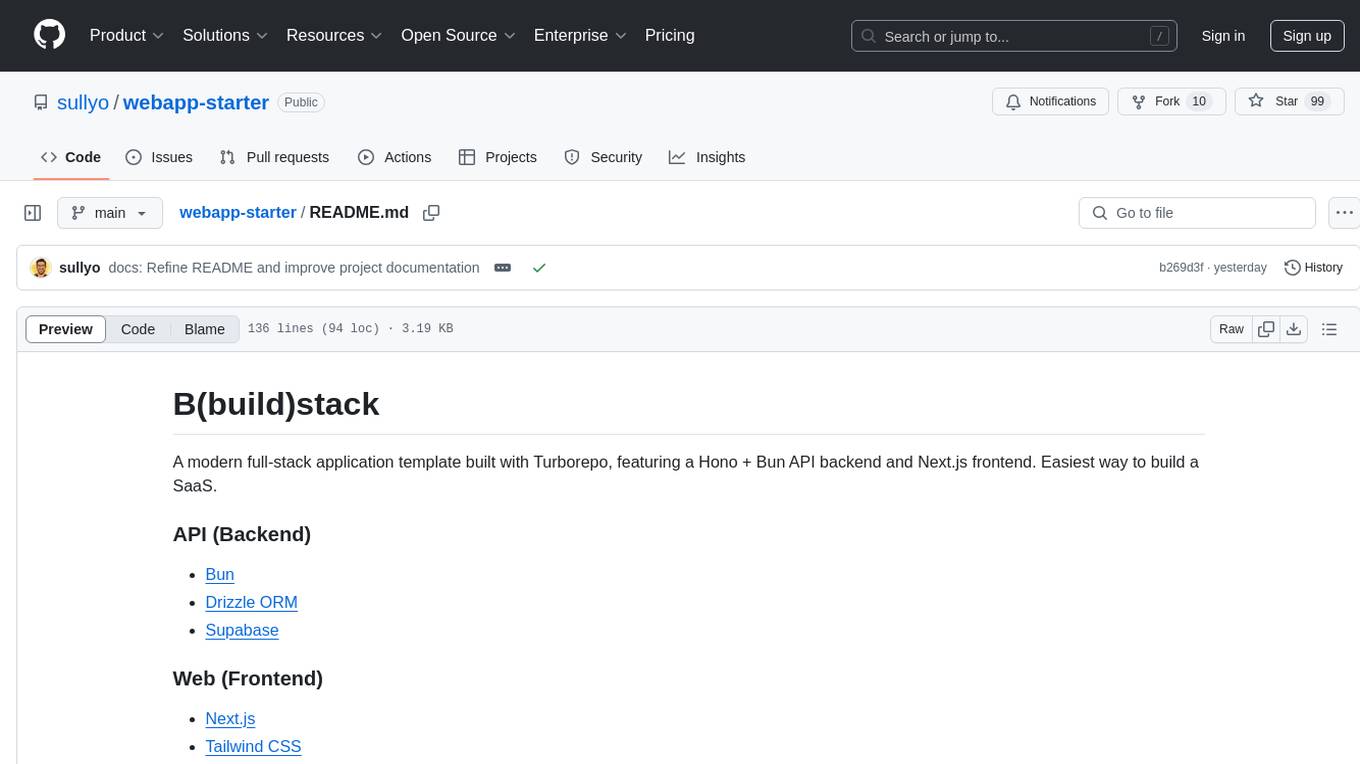
webapp-starter
webapp-starter is a modern full-stack application template built with Turborepo, featuring a Hono + Bun API backend and Next.js frontend. It provides an easy way to build a SaaS product. The backend utilizes technologies like Bun, Drizzle ORM, and Supabase, while the frontend is built with Next.js, Tailwind CSS, Shadcn/ui, and Clerk. Deployment can be done using Vercel and Render. The project structure includes separate directories for API backend and Next.js frontend, along with shared packages for the main database. Setup involves installing dependencies, configuring environment variables, and setting up services like Bun, Supabase, and Clerk. Development can be done using 'turbo dev' command, and deployment instructions are provided for Vercel and Render. Contributions are welcome through pull requests.
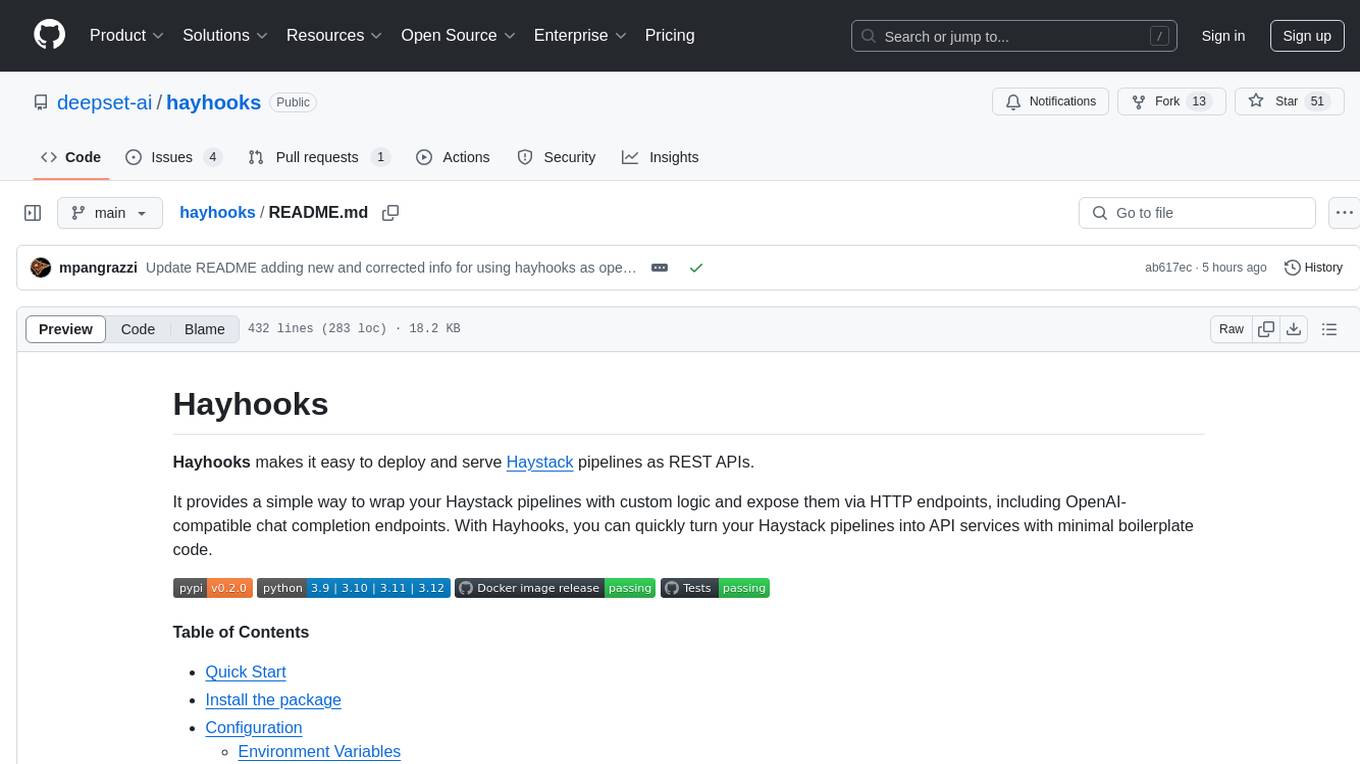
hayhooks
Hayhooks is a tool that simplifies the deployment and serving of Haystack pipelines as REST APIs. It allows users to wrap their pipelines with custom logic and expose them via HTTP endpoints, including OpenAI-compatible chat completion endpoints. With Hayhooks, users can easily convert their Haystack pipelines into API services with minimal boilerplate code.
For similar jobs

trickPrompt-engine
This repository contains a vulnerability mining engine based on GPT technology. The engine is designed to identify logic vulnerabilities in code by utilizing task-driven prompts. It does not require prior knowledge or fine-tuning and focuses on prompt design rather than model design. The tool is effective in real-world projects and should not be used for academic vulnerability testing. It supports scanning projects in various languages, with current support for Solidity. The engine is configured through prompts and environment settings, enabling users to scan for vulnerabilities in their codebase. Future updates aim to optimize code structure, add more language support, and enhance usability through command line mode. The tool has received a significant audit bounty of $50,000+ as of May 2024.
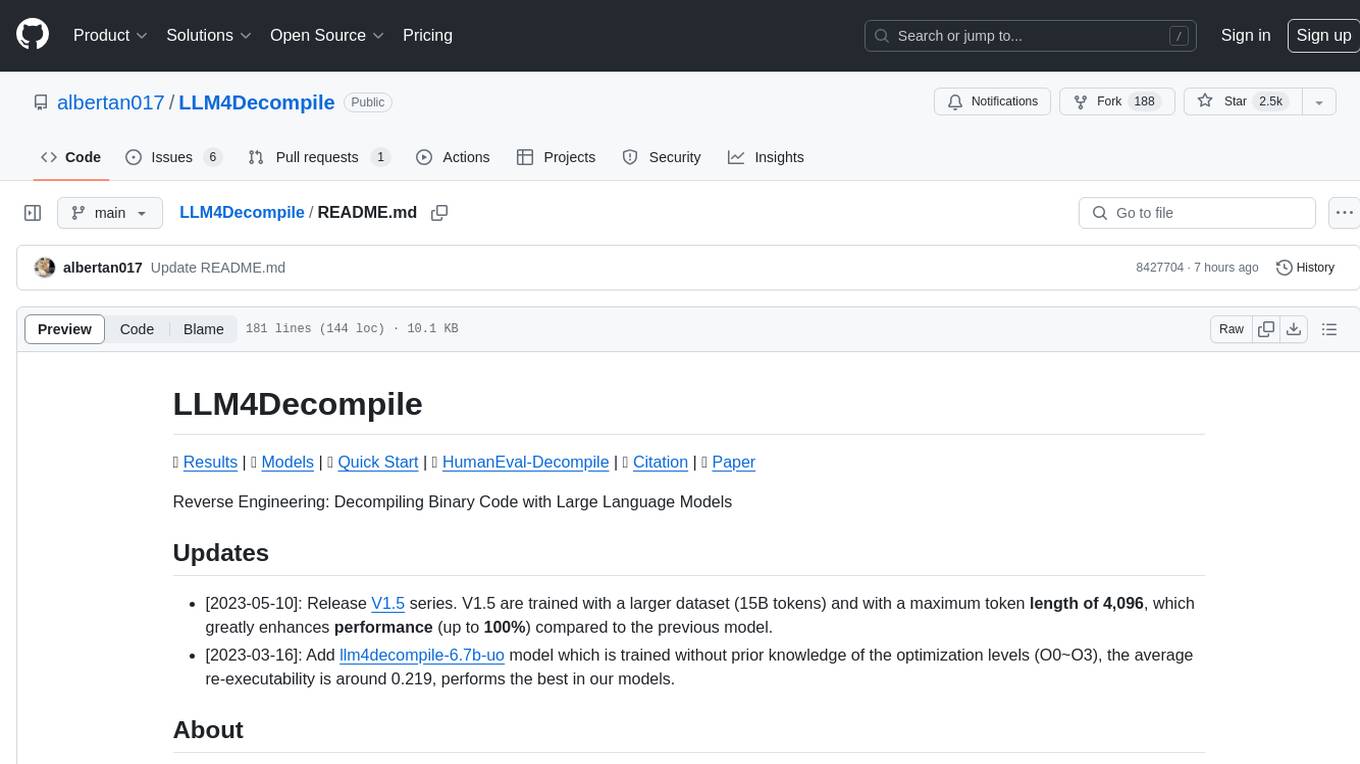
LLM4Decompile
LLM4Decompile is an open-source large language model dedicated to decompilation of Linux x86_64 binaries, supporting GCC's O0 to O3 optimization levels. It focuses on assessing re-executability of decompiled code through HumanEval-Decompile benchmark. The tool includes models with sizes ranging from 1.3 billion to 33 billion parameters, available on Hugging Face. Users can preprocess C code into binary and assembly instructions, then decompile assembly instructions into C using LLM4Decompile. Ongoing efforts aim to expand capabilities to support more architectures and configurations, integrate with decompilation tools like Ghidra and Rizin, and enhance performance with larger training datasets.
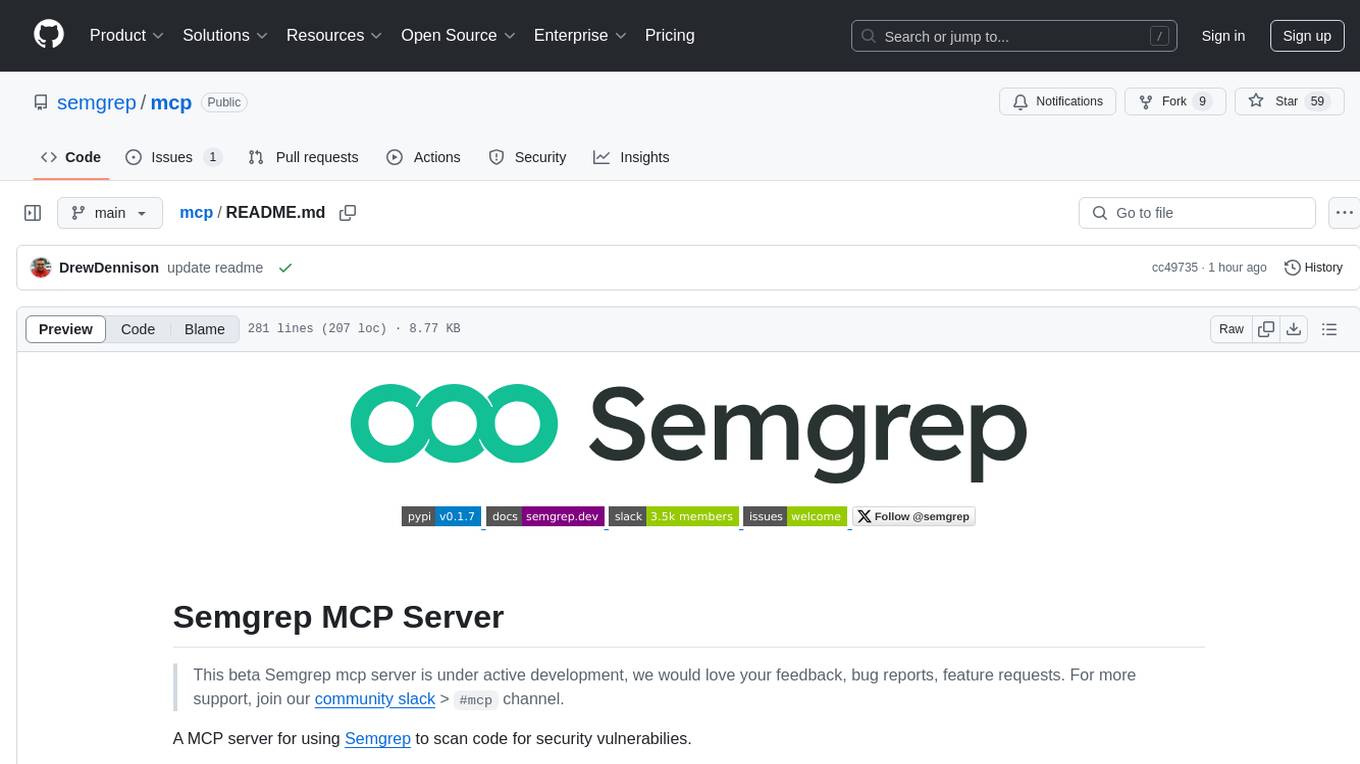
mcp
Semgrep MCP Server is a beta server under active development for using Semgrep to scan code for security vulnerabilities. It provides a Model Context Protocol (MCP) for various coding tools to get specialized help in tasks. Users can connect to Semgrep AppSec Platform, scan code for vulnerabilities, customize Semgrep rules, analyze and filter scan results, and compare results. The tool is published on PyPI as semgrep-mcp and can be installed using pip, pipx, uv, poetry, or other methods. It supports CLI and Docker environments for running the server. Integration with VS Code is also available for quick installation. The project welcomes contributions and is inspired by core technologies like Semgrep and MCP, as well as related community projects and tools.

hound
Hound is a security audit automation pipeline for AI-assisted code review that mirrors how expert auditors think, learn, and collaborate. It features graph-driven analysis, sessionized audits, provider-agnostic models, belief system and hypotheses, precise code grounding, and adaptive planning. The system employs a senior/junior auditor pattern where the Scout actively navigates the codebase and annotates knowledge graphs while the Strategist handles high-level planning and vulnerability analysis. Hound is optimized for small-to-medium sized projects like smart contract applications and is language-agnostic.
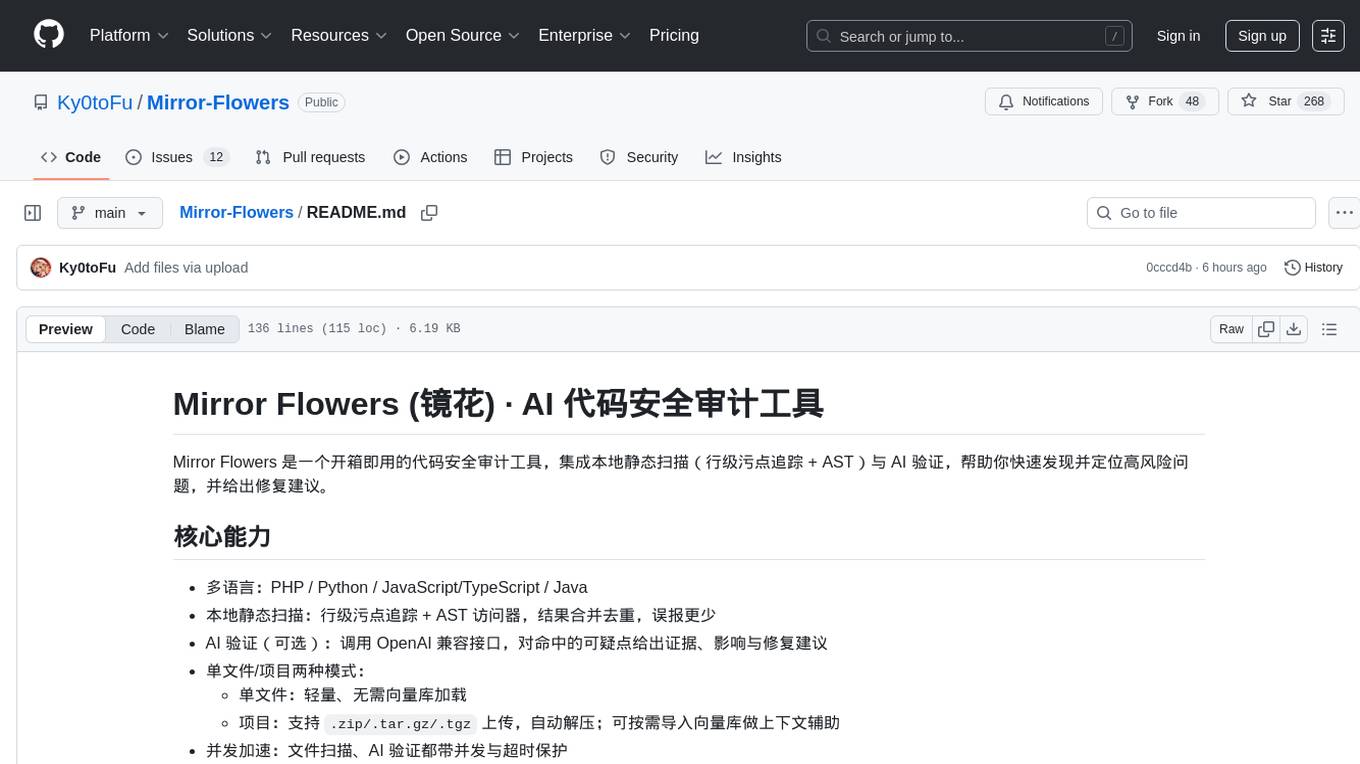
Mirror-Flowers
Mirror Flowers is an out-of-the-box code security auditing tool that integrates local static scanning (line-level taint tracking + AST) with AI verification to help quickly discover and locate high-risk issues, providing repair suggestions. It supports multiple languages such as PHP, Python, JavaScript/TypeScript, and Java. The tool offers both single-file and project modes, with features like concurrent acceleration, integrated UI for visual results, and compatibility with multiple OpenAI interface providers. Users can configure the tool through environment variables or API, and can utilize it through a web UI or HTTP API for tasks like single-file auditing or project auditing.
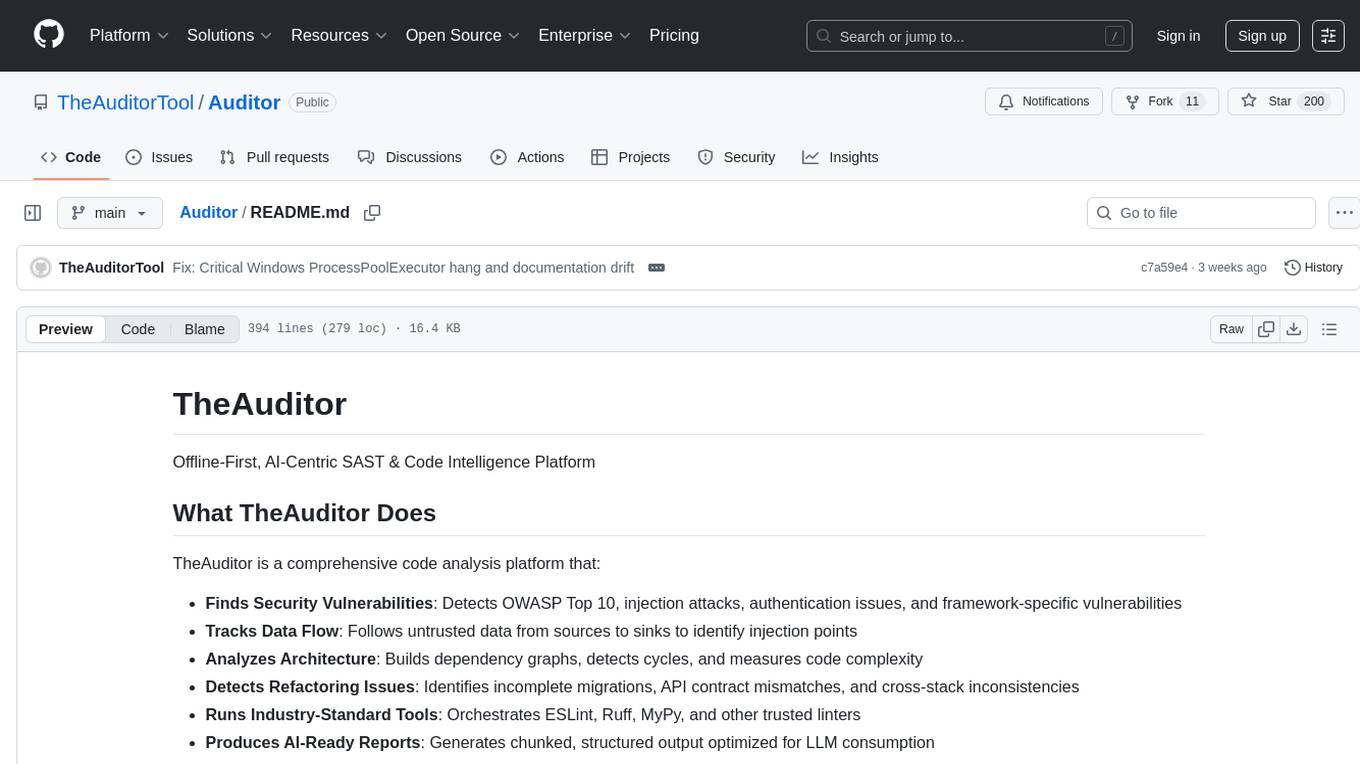
Auditor
TheAuditor is an offline-first, AI-centric SAST & code intelligence platform designed to find security vulnerabilities, track data flow, analyze architecture, detect refactoring issues, run industry-standard tools, and produce AI-ready reports. It is specifically tailored for AI-assisted development workflows, providing verifiable ground truth for developers and AI assistants. The tool orchestrates verifiable data, focuses on AI consumption, and is extensible to support Python and Node.js ecosystems. The comprehensive analysis pipeline includes stages for foundation, concurrent analysis, and final aggregation, offering features like refactoring detection, dependency graph visualization, and optional insights analysis. The tool interacts with antivirus software to identify vulnerabilities, triggers performance impacts, and provides transparent information on common issues and troubleshooting. TheAuditor aims to address the lack of ground truth in AI development workflows and make AI development trustworthy by providing accurate security analysis and code verification.
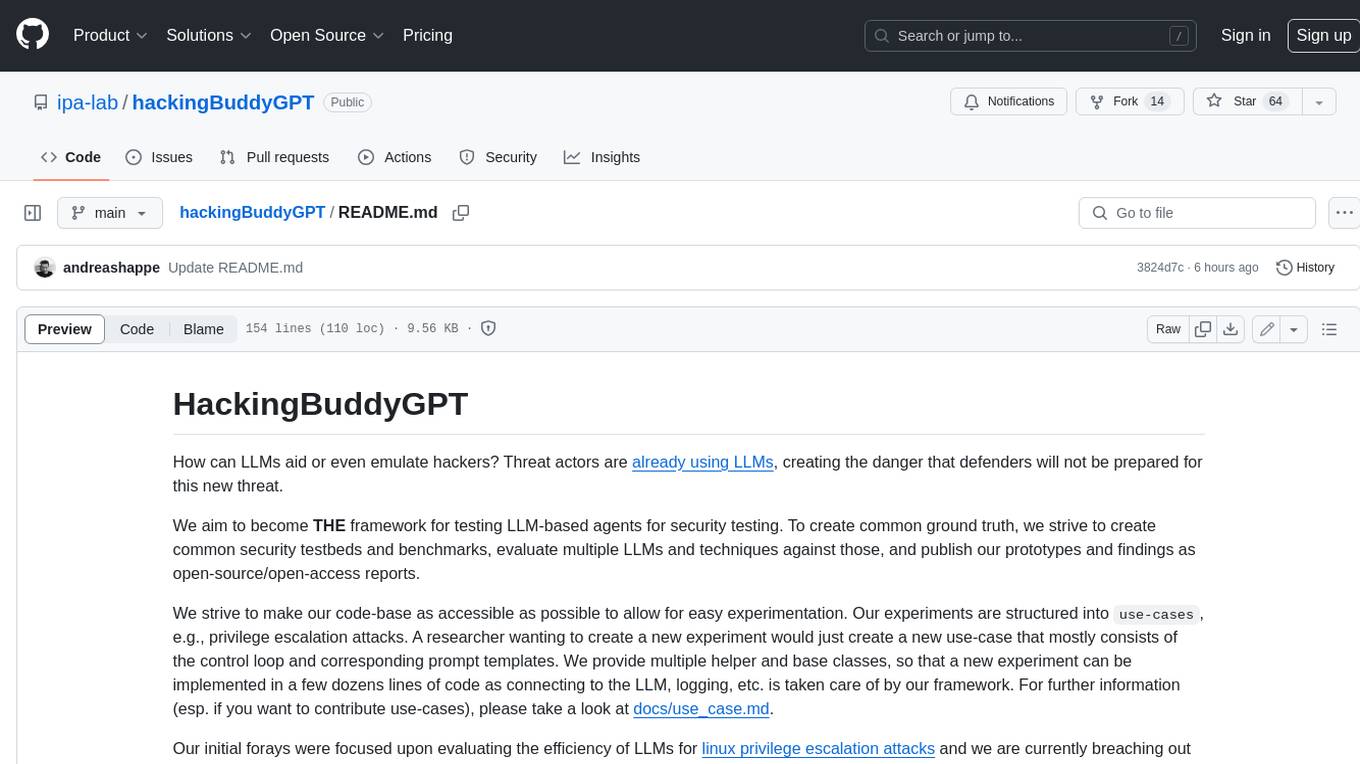
hackingBuddyGPT
hackingBuddyGPT is a framework for testing LLM-based agents for security testing. It aims to create common ground truth by creating common security testbeds and benchmarks, evaluating multiple LLMs and techniques against those, and publishing prototypes and findings as open-source/open-access reports. The initial focus is on evaluating the efficiency of LLMs for Linux privilege escalation attacks, but the framework is being expanded to evaluate the use of LLMs for web penetration-testing and web API testing. hackingBuddyGPT is released as open-source to level the playing field for blue teams against APTs that have access to more sophisticated resources.
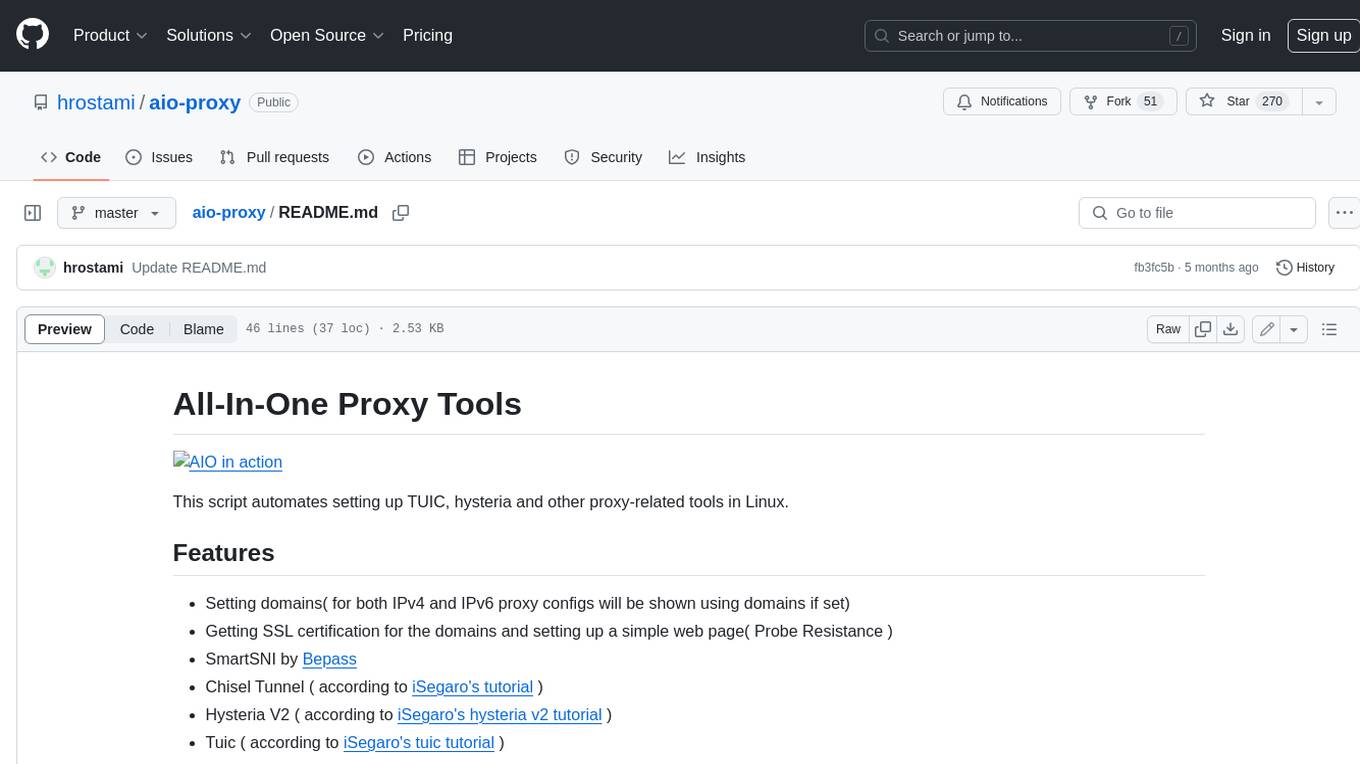
aio-proxy
This script automates setting up TUIC, hysteria and other proxy-related tools in Linux. It features setting domains, getting SSL certification, setting up a simple web page, SmartSNI by Bepass, Chisel Tunnel, Hysteria V2, Tuic, Hiddify Reality Scanner, SSH, Telegram Proxy, Reverse TLS Tunnel, different panels, installing, disabling, and enabling Warp, Sing Box 4-in-1 script, showing ports in use and their corresponding processes, and an Android script to use Chisel tunnel.
